15.1: Politics, Power, and Authority
15.1.1: Politics
Political sociology studies the relation between state and society, authority and power, and the methods used to formulate social policy.
Learning Objective
Diagram the three major traditional theoretical frameworks of political sociology, plus trends in contemporary sociology
Key Points
- The term “politics” is generally applied to behavior within civil governments, but politics has been observed in all human group interactions. It consists of social relations involving authority or power, the regulation of political units, and the methods used to formulate and apply social policy.
- Traditionally there have been four main areas of research: the socio-political formation of the modern state; how social inequality influences politics; how social movements outside of the formal institutions affect formal politics; and power relationships within and between social groups.
- There are three major theoretical frameworks: pluralism, elite or managerial theory, and class analysis.
- Pluralism sees politics primarily as a contest among competing interest groups. It holds the view that politics and decision making are located mostly in the framework of government, but many non-governmental groups use their resources to exert influence.
- Elite or managerial theory is sometimes called a state-centered approach. It posits that a small minority—consisting of members of the economic elite and policy-planning networks—holds the most power and that this power is independent of a state’s democratic elections process.
- Social class theory analysis emphasizes the political power of capitalist elites.
Key Terms
- state
-
Any sovereign polity. A government.
- social policy
-
Guidelines, principles, legislation and activities that affect the living conditions conducive to human welfare.
- politics
-
the art or science of influencing people on a civic, or individual level, when there are more than 2 people involved
Example
- If you’ve ever joined a group or a club, you have probably witnessed politics in process. Even groups we don’t think of as political still practice politics. For example, a school sports team has its own politics. The team’s coach exercises authority over the team’s players; in turn, the coach must answer to the authorities of the school or the state athletic association concerning when and where the team can practice and compete. Usually, decisions will be made by the coach, but some coaches may also appoint team captains who have a say in decision-making. On some especially democratic teams, all players may have some say in certain decisions. This is politics.
Politics is the process by which groups of people make decisions. The term is generally applied to behavior within civil governments, but politics has been observed in all human group interactions, including corporate, academic, and religious institutions. It consists of social relations involving authority or power, the regulation of political units, and the methods and tactics used to formulate and apply social policy.
Contemporary political sociology involves the study of relations between state and society.
In the past, a typical research question in political sociology might have been: “Why do so few American citizens choose to vote? ” or “What difference does it make if women get elected? “
Modern political sociologists are now focused on questions such as: “How is the body a site of power? “, “How are emotions relevant to global poverty? “, or “What difference does knowledge make to democracy? “
Traditional Political Sociology
Traditionally there have been four main areas of research in political sociology:
- The socio-political formation of the modern state
- “Who rules? ” How social inequality between groups (class, race, gender, etc.) influences politics
- How public personalities, social movements, and trends outside of the formal institutions of political power affect formal politics
- Power relationships within and between social groups (e.g. families, workplaces, bureaucracy, media, etc.).
Political sociology was traditionally concerned with how social trends, dynamics, and structures of domination affect formal political processes. It also explored how various social forces work together to change political policies. From this perspective there are three major theoretical frameworks: pluralism, elite or managerial theory, and class analysis (which overlaps with Marxist analysis).
Pluralism
Pluralism sees politics as a contest between competing interest groups. It holds the view that politics and decision making are located mostly in the framework of government, but many non-governmental groups use their resources to exert influence. Groups of individuals try to maximize their interests. There are multiple lines of power that shift as power is a continuous bargaining process between competing groups. Any change under this view will be slow and incremental—groups have different interests and may act as “veto groups” to destroy legislation that they do not agree with.
Elite/Managerial Theory
Elite or managerial theory is sometimes called a state-centered approach. It also seeks to describe and explain power relationships in contemporary society. The theory posits that a small minority—consisting of members of the economic elite and policy-planning networks—holds the most power. This power is independent of a state’s democratic elections process. Through positions in corporations, corporate boards, and policy-planning networks, members of the “elite” are able to exert significant power over the policy decisions of corporations and governments.
Class Analysis
Social class analysis emphasizes the political power of capitalist elites. It can be split into two parts. One is the ‘power structure’ or ‘instrumentalist’ approach; the other is the ‘structuralist’ approach. The power structure approach focuses on determining who rules, while the structuralist approach emphasizes the way a capitalist economy operates, allowing and encouraging the state to do some things but not others.
Contemporary Political Sociology
Contemporary political sociology is concerned with the play of power and politics across societies, which includes, but is not restricted to relations between the state and society. In part, this is a product of the growing complexity of social relations, the impact of social movement organizing, and the relative weakening of the state via globalization. Political sociology is as much focused on micro questions (the formation of identity through social interaction; the politics of knowledge), as it is on macro questions (how to capture and use state power).
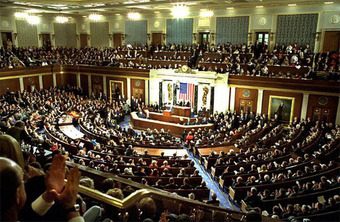
President Bush’s 2003 State of the Union Address
Politics is a decision making process, which often takes place in legislative bodies such as the U.S. Congress.
15.1.2: Power
Power is frequently defined as the ability to influence the behavior of others with or without resistance.
Learning Objective
Differentiate between power and constraint, using real life examples
Key Points
- Power can be seen as evil or unjust, but the exercise of power is accepted as endemic to humans as social beings. The use of power need not involve coercion, force or the threat of force.
- The sociological examination of power concerns itself with discovering and describing the relative strengths: equal or unequal; stable or subject to periodic change.
- Power may derive from a number of sources, including social class (material wealth can equal power), resource currency (material items such as money, property, food), personal or group charisma, or social influence of tradition (compare ascribed power).
- Researchers have documented the bystander effect: they found that powerful people are three times as likely to first offer help to a stranger in distress.
Key Terms
- power elite
-
a small group of people who control a disproportionate amount of wealth or political power
- bystander effect
-
When someone is less likely to help another if other potential helpers are present.
- unilateralism
-
A tendency of nations to act on their own, or with only minimal consultation and involvement with other nations.
- power
-
The ability to get one’s way even in the face of opposition to one’s goals.
Example
- Employer-employee relationships offer an example of power relations. Typically, the employer (or boss) has more power. That is, the balance of power tips in her favor: she can threaten to fire an employee, reduce his salary, assign undesirable tasks, and so on. By comparison, the employee has less power. Labor unions attempt to bring more balance into this relationship by forming large coalitions of employees who, by working together, can exert power of their own.
Power is frequently defined by political scientists as the ability to influence the behavior of others with or without resistance. The term authority is often used for power perceived as legitimate by the social structure. Power can be seen as evil or unjust, but the exercise of power is accepted as endemic to humans as social beings. The use of power need not involve coercion, force or the threat of force. At one extreme, power closely resembles what English speakers call “influence”, although some authors make a distinction between the two.
The sociological examination of power involves discovering and describing the relative strengths: equal or unequal; stable or subject to periodic change. Sociologists usually analyze relationships in which parties have relatively equal or nearly equal power in terms of constraint rather than of power. Thus power has a connotation of unilateralism. If this were not so, then all relationships could be described in terms of power, and its meaning would be lost.
Power may derive from a number of sources, including social class (material wealth can equal power), resource currency (material items such as money, property, food), personal or group charisma, ascribed power (acting on perceived or assumed abilities, whether these bear testing or not), social influence of tradition (compare ascribed power), etc.
People use more than rewards, threats and information to influence others. In everyday situations, people use a variety of power tactics to push or prompt others into particular action. There are many examples of power tactics that are quite common and employed everyday. Some of these tactics include bullying, collaboration, complaining, criticizing, demanding, disengaging, evading, humor, inspiring, manipulating, negotiating, socializing and supplicating. Recent experimental psychology suggests that the more power one has the less one takes on the perspective of others, implying that the powerful have less empathy.
Powerful people are also more likely to take action. In one example, more powerful people turned off an irritatingly close fan twice as much as less powerful people. Researchers have documented the “bystander effect” and found that powerful people are three times as likely to first offer help to a stranger in distress.
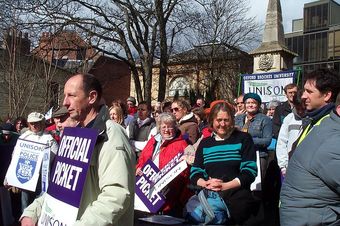
A rally of the trade union UNISON in Oxford during a strike
Labor unions attempt to bring more balance into the relationship between employers and employees by forming large coalitions of employees who, by working together, can exert power of their own.
15.1.3: Authority
Authority refers to the use of power that is seen as legitimate or socially approved/recognized.
Learning Objective
Give examples of the three types of authority as defined by Max Weber and what distinguishes all of them from coercion or force
Key Points
- Power can be exerted by the use of force or violence. Authority, by contrast, depends on subordinate groups consenting to the use of power wielded by superior groups.
- Weber defined domination (authority) as the chance of commands being obeyed by a specifiable group of people. Legitimate authority is that which is recognized as legitimate and justified by both the ruler and the ruled.
- Weber states that legitimacy distinguishes authority, from coercion, force, power, leadership, persuasion and influence. Superiors, he states, feel that they have a right to issue commands; subordinates perceive an obligation to obey.
- Authoritarianism primarily differs from totalitarianism in that social and economic institutions exist that are not under governmental control.
- The three attributes of authority are status, specialist skills, and social position.
Key Terms
- authority
-
The power to enforce rules or give orders.
- power
-
The ability to get one’s way even in the face of opposition to one’s goals.
Examples
- Authority only lasts so long as people recognize the legitimacy of power. But when people begin to question the legitimacy of that power, it loses authority. For example, when American colonists began to question the legitimacy of Britain’s rule over the colony, Britain lost its authority. Without authority, Britain’s power had to be backed by force.
- In democratic countries, people recognize the legitimacy of power obtained through free and fair elections. After an election, the winning party takes office without a struggle or show of military force because everyone recognizes the legitimacy of its newly won authority.
Authority is the legitimate or socially approved use of power that a person or a group holds over another. Legitimacy is vital to the notion of authority; legitimacy is the main means by which authority is distinguished from more general notions of power. Power can be exerted by the use of force or violence. Authority, by contrast, depends on subordinate groups consenting to the use of power wielded by superior groups.
Max Weber, in his sociological and philosophical work, identified and distinguished three types of legitimate domination (Herrschaft in German, which generally means ‘domination’ or ‘rule’). These have sometimes been translated to English as types of authority, because domination is not seen as a political concept. Weber defined domination (authority) as the chance of commands being obeyed by a specifiable group of people. Legitimate authority is that which is recognized as legitimate and justified by both the ruler and the ruled.
The first type discussed by Weber is rational-legal authority. It is a form of authority with legitimacy that depends on formal rules and established laws of the state, which are usually written down and are often very complex.
The second type of authority is traditional authority, which derives from long-established customs, habits, and social structures. When power passes from one generation to another, it is known as traditional authority.
The third form of authority is charismatic authority. Here, the charisma of the individual or the leader plays an important role.
Weber states that legitimacy distinguishes authority from coercion, force, power, leadership, persuasion, and influence. Superiors, he states, feel that they have a right to issue commands; subordinates perceive an obligation to obey. The degree to which these rights and obligations are felt is based on the perceived legitimacy of the authority. A well-established, respected, democratically elected government typically wields more authority than an ad hoc, temporary, or corrupt government.

A Teacher’s Authority
Teachers have authority because students recognize that their power over the classroom is legitimate.
15.1.4: Authority and Legitimate Violence
Max Weber conceived of the state as a monopoly of the legitimate use of physical force.
Learning Objective
Assess Weber’s argument about the state’s relationship to physical force
Key Points
- Weber defines the state as a community successfully claiming authority over legitimate use of physical force in a given territory.
- Besides the police and the military, private force can be used too, as long as it has legitimacy derived from the state.
- The right of self-defense is the right by which civilians acting on their own behalf may engage in violence for the sake of defending one’s own life or the lives of others.
Key Terms
- monopoly
-
a situation in which one party or company exclusively provides a particular product or service, dominating that market and generally exerting powerful control over it
- Max Weber
-
(1864–1920) A German sociologist, philosopher, and political economist who profoundly influenced social theory, social research, and the discipline of sociology itself.
- right of self-defense
-
The right of self-defense (according to U.S. law) is the right by which civilians acting on their own behalf may engage in violence for the sake of defending one’s own life or the lives of others, including the use of deadly force.
- the state
-
A state is a political organization with a centralized government that maintains a monopoly over the legitimate use of force within a certain territory.
Example
- Max Weber’s theory about states and violence can help explain why states would want to enact policies like gun control. In order to maintain a monopoly on legitimate violence, states must limit the means by which others may carry out violent acts. By controlling access to guns, the state furthers this objective. Proponents of gun control argue that limiting access to guns promotes public safety. Opponents of gun control point out that this increases a state’s authority while diminishing the possibility for armed resistance by private individuals.
Max Weber, in Politics as a Vocation, conceived of the state as a monopoly of the legitimate use of physical force. According to Weber, the state is that entity that “upholds the claim to the monopoly of the legitimate use of physical force in the enforcement of its order. ” The state’s authority is derived from this: the state can enforce its precepts through force without losing its legitimate authority. This definition of the state has figured prominently in philosophy of law and in political philosophy throughout the twentieth century.
Ownership of territory is another characteristic that Weber deemed prerequisite for a state. Territory is necessary because it defines the scope of the state’s authority: use of force is acceptable, but only in the jurisdiction specified by the state’s lands. Such a monopoly, according to Weber, must occur via a process of legitimation.
The police and the military are the state’s main instruments of legitimate violence, but this does not mean that only public force can be used: private force can be used, too, as long as it has legitimacy derived from the state. The right of self-defense is the right by which civilians acting on their own behalf may engage in violence for the sake of defending one’s own life or the lives of others, including the use of deadly force. In any instance where an individual uses force to defend a third party, it must be demonstrated that the third party was in a position that required another individual’s intervention. The right of self-defense is a private form of legitimate violence that is recognized by the state.

A Helicopter Operated by Blackwater Worldwide
Blackwater Worldwide is private military company that contracts with the United States to provide military services. States may maintain a monopoly on legitimate violence but outsource its execution by contracting with private parties such as Blackwater.
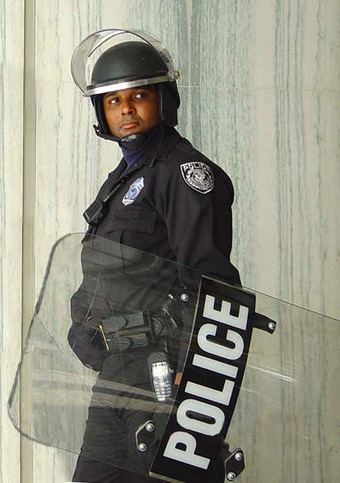
A police officer
States maintain a monopoly on violence, exercised by police officers.
15.1.5: Traditional Authority
Traditional authority refers to a form of leadership in which authority derives from tradition or custom.
Learning Objective
Compare patrimonial government with feudalism within the context of traditional authority
Key Points
- Weber traced traditional domination back to patriarchs, their households, and the ancient tradition of family. In such systems, the master is designated in accordance with the rules of inheritance.
- Patrimonial government occurs when the ruler’s household expands to governmental offices. All officials are personal dependents or favorites of the ruler, and are appointed by him.
- Feudalism replaced the paternal relationship of patrimonalism with a contract of allegiance based on knightly militarism.
Key Terms
- tradition
-
A part of culture that is passed from person to person or generation to generation, possibly differing in detail from family to family, such as the way holidays are celebrated.
- patrimonial government
-
A form of governance in which all power flows directly from the leader. The leaders of these countries typically enjoy absolute personal power.
- feudalism
-
A social system that is based on personal ownership of resources and personal fealty between a suzerain (lord) and a vassal (subject). Defining characteristics of feudalism are direct ownership of resources, personal loyalty, and a hierarchical social structure reinforced by religion.
Example
- Traditional authority is generally associated with monarchies or tribal systems. For example, historically, kings derived their authority from tradition. They gained power through a line of succession. They became kings because their fathers before them had been kings, not because of any special ability or popularity. They remained in power because it was a tradition in those societies to have a king as a ruler, and subjects did not question the legitimacy of the king’s reign over his kingdom.
Traditional Authority
Traditional authority is a type of leadership in which the authority of a ruling regime is largely tied to tradition or custom. In sociology, the concept of traditional authority comes from Max Weber’s tripartite classification of authority. In addition to traditional authority, Weber claimed that the other two styles of authority were charismatic authority and rational-legal authority. Weber noted that, in history, these ideal types of domination always seemed to occur in combinations.
Weber traced traditional domination back to patriarchs, their households, and the ancient tradition of the family. In such systems, the master, almost exclusively an older father, is designated in accordance with the rules of inheritance. He has no administrative staff, nor any machinery to enforce his will by force alone. Instead, he depends on the willingness of subservient group members to respect his authority. They obey him based on the belief that this is their duty, sanctioned by tradition.
Patrimonial government is related to this model, but is slightly different. This occurs when a patriarchal ruler’s household expands to governmental offices. In this style of leadership, all officials are personal dependents or favorites of the ruler, and are appointed by the ruler. Their interactions with the ruler are based on paternal authority and filial dependence. Military force is an important instrument of patrimonial rule. Patrimonial dominance has often prevailed in the Orient.
Patrimonalism and Feudalism
In comparison to patrimonalism, feudalism has one major similarity and several important differences. The similarity is that both are based on tradition and have powerful rulers who grant rights in return for military and administrative services. There are two important differences. First, feudalism replaced the paternal relationship of patrimonalism with a contract of allegiance based on knightly militarism. Second, in a patrimonial government, officials are personally dependent on the patriarch. In feudalism, these individuals are replaced with vassals, who have contractual freedom, personal allegiance, and socioeconomic prominence.
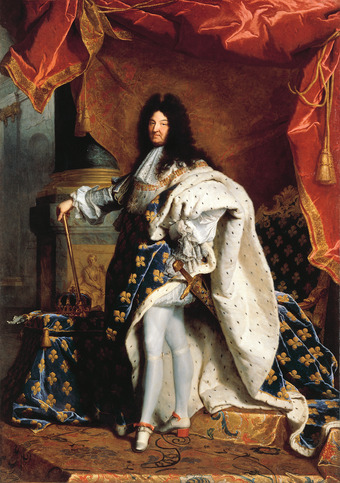
Louis XIV of France
Historically, kings have derived their authority from tradition.
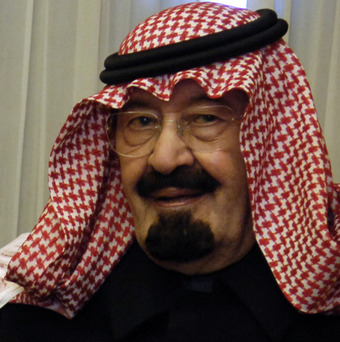
King Abdullah bin Abdul al-Saud of Saudi Arabia
King Abdullah bin Abdul al-Saud, King of Saudi Arabia, derived his authority from tradition.
15.1.6: Rational-Legal Authority
Rational-legal authority is a form of leadership in which authority is largely tied to legal rationality, legal legitimacy, and bureaucracy.
Learning Objective
Recall the three characteristics of the modern state, according to Weber
Key Points
- Unlike charismatic authority and traditional authority, rational-legal authority derives its powers from the system of bureaucracy and legality.
- Weber defined legal order as a system wherein the rules are enacted and obeyed as legitimate because they are in line with other laws on how they can be enacted and how they should be obeyed.
- The modern state based on rational-legal authority emerged from the patrimonial and feudal struggle for power uniquely in Western civilization.
- A modern state exists where a political community has created an administrative and legal order, binding authority over citizens, and the legitimate use of physical force.
Key Terms
- bureaucracy
-
Structure and regulations in place to control activity. Usually in large organizations and government operations.
- legal order
-
A system where the rules are enacted and obeyed as legitimate because they are in line with other laws on how they can be enacted and how they should be obeyed. Further, they are enforced by a government that monopolizes their enactment and the legitimate use of physical force.
- authority
-
The power to enforce rules or give orders.
Example
- Different forms of authority transfer power in different ways. In traditional authority, power is usually passed on through a family line. In rational-legal authority, power is passed on according to a set of rules. In the United States, for example, presidential power is passed on through elections. Elections must follow specific rules to ensure they are fair: all eligible voters must be allowed to vote, no poll tax can be charged because it would discriminate against those who could not pay, and so on. Although individual voters may choose which candidate they favor based on a candidate’s charisma or family background, the election itself must follow rational-legal requirements. When election results are disputed, they are decided by referring back to those rules. Thus, for example, when the 2000 election between Bush and Gore came down to a very close vote, it was decided by a careful review of ballots and voting procedures, not by anything having to do with the qualifications of the candidates.
Rational-legal authority is a form of leadership in which the authority of an organization or a ruling regime is largely tied to legal rationality, legal legitimacy, and bureaucracy. It is the second of Max Weber’s tripartite classification of authority. The majority of the modern states of the twentieth century are rational-legal authorities, according to those who use this form of classification .
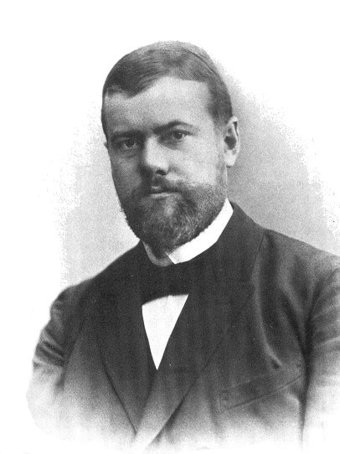
Max Weber
Max Weber and Wilhelm Dilthey introduced verstehen—understanding behaviors—as goal of sociology.
Unlike charismatic authority and traditional authority, rational-legal authority derives its powers from the system of bureaucracy and legality. Weber defined legal order as a system wherein the rules are enacted and obeyed as legitimate because they are in line with other laws on how they can be enacted and how they should be obeyed. These rules are enforced by a government that monopolizes their enactment, while holding the legitimate use of physical force.
Weber wrote that the modern state based on rational-legal authority emerged from the patrimonial and feudal struggle for power uniquely in Western civilization. The prerequisites for the modern Western state are the monopoly by a central authority of the means of administration and control; the monopoly of legislative authority; and the organization of officialdom, dependent upon the central authority.
According to Max Weber, a modern state exists where a political community has three elements. First, an administrative and legal order that has been created and can be changed by legislation that also determines its role. Second, it must have binding authority over citizens and actions in its jurisdiction. Lastly, it must possess the right to legitimately use the physical force in its jurisdiction.
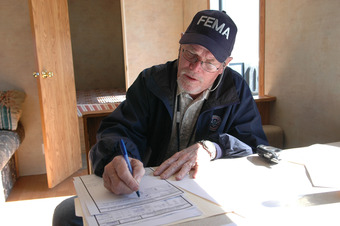
A FEMA Employee Fills Out Paperwork
Ration-legal authority depends on routinized administration, which often involves a lot of paperwork.
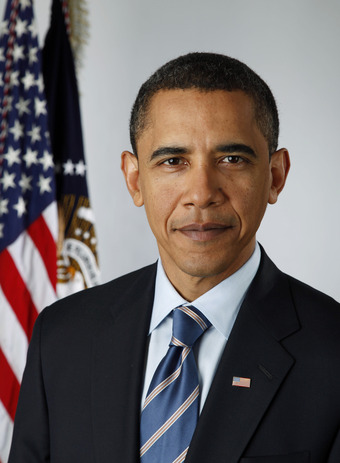
President Barack Obama
Barack Obama, President of the United States, derives his authority from a rational-legal system of laws outlined in a formal document, the Constitution of the United States of America.
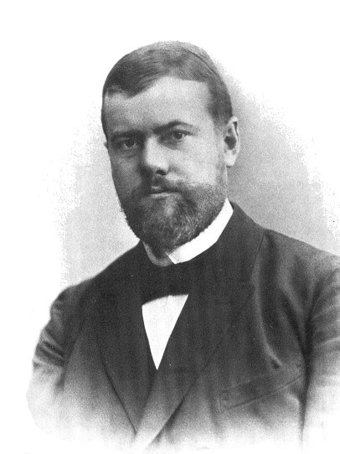
Max Weber on Rational-Legal Authority
According to Weber, rational-legal authority is a form of leadership in which the authority of an organization or a ruling regime is largely tied to legal rationality, legal legitimacy, and bureaucracy.
15.1.7: Charismatic Authority
Charismatic authority is power legitimized by a leader’s exceptional personal qualities, which inspire loyalty and obedience from followers.
Learning Objective
Create a model of a hypothetical charismatic leader in a hypothetical government which describes the charisma and explains in detail how it is legitimized, used, and maintained
Key Points
- For Weber, charisma applies to “a certain quality of an individual personality, by virtue of which he is set apart from ordinary men and treated as endowed with supernatural powers”.
- In contrast to the current popular use of the term charismatic leader, Weber saw charismatic authority not so much as character traits of the charismatic leader, but as a relationship between the leader and his followers.
- A cult of personality refers to when an individual uses mass media, propaganda, or other methods to create an idealized and heroic public image, often through unquestioning flattery and praise.
- The methods of charismatic succession are search, revelation, designation by original leader, designation by qualified staff, hereditary charisma, and office charisma.
Key Terms
- cult of personality
-
A situation where a leader (often a dictator) has been falsely idolized and made into a national or group icon and is revered as a result.
- routinization
-
Charismatic authority almost always endangers the boundaries set by traditional or rational (legal) authority. It tends to challenge this authority, and is thus often seen as revolutionary. Usually this charismatic authority is incorporated into society. Hereby the challenge that it presents to society will subside. The way in which this happens is called routinization.
- revelation
-
A manifestation of divine truth.
Example
- In popular speech, we think of charisma as a positive personality trait, but for Max Weber, charisma referred simply to a relationship between a leader and his or her subjects. Charismatic leaders gain authority not because they are necessarily kind, but because they are seen as superhuman. Thus, Hitler and Mussolini can be seen as examples of charismatic leaders.
Charismatic authority is one of three forms of authority laid out in Max Weber’s tripartite classification of authority. Weber defined charismatic authority as “resting on devotion to the exceptional sanctity, heroism or exemplary character of an individual person, and of the normative patterns or order revealed or ordained by him” .
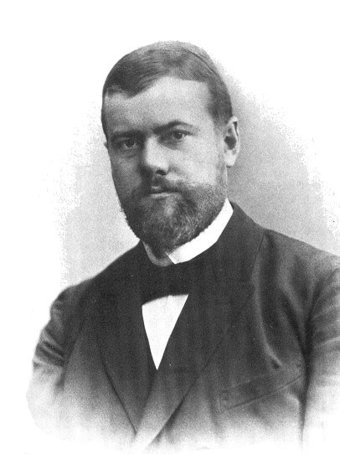
Max Weber
Weber defined charismatic authority as “resting on devotion to the exceptional sanctity, heroism or exemplary character of an individual person, and of the normative patterns or order revealed or ordained by him.”
Charismatic authority is power legitimized on the basis of a leader’s exceptional personal qualities, or the demonstration of extraordinary insight and accomplishment, which inspire loyalty and obedience from followers. In contrast to the current popular use of the term charismatic leader, Weber saw charismatic authority not so much as character traits of the charismatic leader but as a relationship between the leader and his followers. For Weber, charisma applies to “a certain quality of an individual personality, by virtue of which he is set apart from ordinary men and treated as endowed with supernatural, superhuman, or at least specifically exceptional powers or qualities. “
Charismatic authority almost always evolves in the context of boundaries set by traditional or rational-legal authority, but by its nature tends to challenge this authority, and is thus often seen as revolutionary. However, the constant challenge that charismatic authority presents to a particular society will eventually subside as it is incorporated into that society through routinization. Routinization is the process by which “charismatic authority is succeeded by a bureaucracy controlled by a rationally established authority or by a combination of traditional and bureaucratic authority. “
In politics, charismatic rule is often found in various authoritarian states, autocracies, dictatorships, and theocracies. In order to help to maintain their charismatic authority, such regimes will often establish a vast cult of personality, which is signaled when an individual uses mass media, propaganda, or other methods to create an idealized and heroic public image, often through unquestioning flattery and praise. When the leader of such a state dies or leaves office and a new charismatic leader does not appear, such a regime is likely to fall shortly thereafter unless it has become fully routinized.
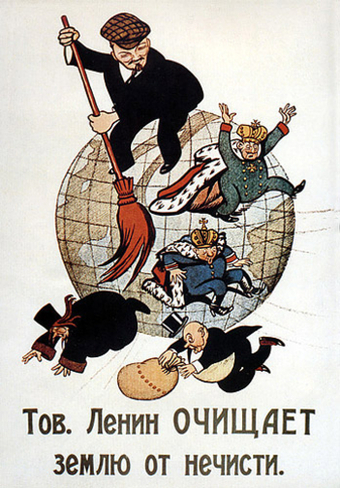
Lenin, a charismatic leader
Bolshevik political cartoon poster from 1920 depicting Lenin sweeping away monarchists and capitalists; the caption reads, “Comrade Lenin Cleanses the Earth of Filth.”
According to Max Weber, the methods of charismatic succession are search, revelation, designation by original leader, designation by qualified staff, hereditary charisma, and office charisma. These are the various ways in which an individual and a society can contrive to maintain the unique energy and nature of charisma in their leadership.
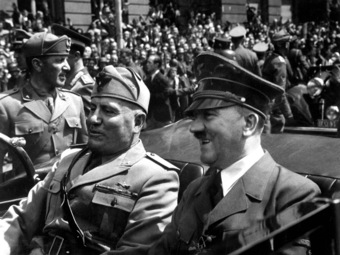
Mussolini and Hitler
According to Weber, charismatic leaders gain authority not because they are necessarily kind, but because they are seen as superhuman.
15.1.8: The Transfer of Authority
In the United States, transfers of authority generally occur after presidential elections.
Learning Objective
Compare presidential transitions with transitional justice using real-life examples
Key Points
- A presidential transition refers to the period of time between the end of a presidential election and the inauguration of a new president.
- In the United States, during a presidential transition, the outgoing, “lame duck” president has lost many of the intangible benefits of a presidency, but the incoming president-elect is not yet legally empowered to enforce policy.
- Transitional justice refers to a range of efforts, on the part of the state, to address past human rights violations. These efforts include both judicial and non-judicial methods.
- In the context of transitional justice, memorialization is used to honor the victims of human rights abuses.
Key Terms
- Presidential transition
-
A presidential transition or presidential interregnum refers to the period of time between the end of a presidential election and the inauguration of a new president.
- transitional justice
-
Transitional justice generally refers to a range of approaches that states may use to address past human rights violations. This includes both judicial and non-judicial approaches.
- president-elect
-
a person who has been elected to a presidency but has not yet been inducted into office
Presidential Transitions
A presidential transition refers to the period of time between the end of a presidential election and the inauguration of a new president. During this time, the incoming president usually designates new governmental personnel, including those individuals who will either serve in the cabinet or lead governmental agencies.
In the United States, the presidential transition extends from the date of the presidential election, in early November, until the twentieth day of January in the following year. This was specified in the Twentieth Amendment to the Constitution. During a presidential transition, the outgoing president, also known as the “lame duck,” has lost many of the intangible benefits of a presidency. That being said, the incoming president-elect is not yet legally empowered to enforce policy. This ambiguity, between the president-elect and outgoing president, creates the potential for a leadership vacuum, which may be most acutely felt during wartime or times of economic crisis.
Transitional Justice
In other nations, many of which have experienced undemocratic governments and dictators, transitional justice refers to a state’s efforts to address past human rights violations. These efforts can be both judicial and non-judicial, and refer to actions, policies or institutions that are enacted at a point of political transition from violence or repression to societal stability. As a project, transitional justice has a number of goals, including rebuilding social trust, repairing a fractured judicial system, and building a democratic system of governance.
In the context of transitional justice, memorialization is used to honor the victims of human rights abuses. By demonstrating respect and acknowledging the past, national memorials can help governments reconcile tensions with victims. They can also help to establish a record of history and to prevent the recurrence of abuse.
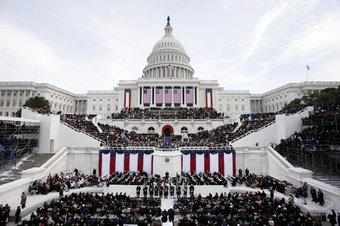
Presidential Inauguration, 2005
In the United States, elaborate inauguration ceremonies mark the transfer of authority.
15.2: Government and the State
15.2.1: Functions of the State
Various schools of thought consider the state to be either a neutral entity separated from society or an immoral partisan instrument.
Learning Objective
Classify the different political theories concerning the function of the state in society
Key Points
- Liberal and conservative theories of the state tend to see the state as a neutral entity separated from society and the economy. These theories treat the economic system of capitalism as a given.
- Marxist theories see the state as a partisan instrument that primarily serves the interests of the upper class. These theories emphasize the relationship between political power and economic power.
- Anarchists believe that the state apparatus should be completely dismantled and an alternative set of social relations created. These social relations would not be based on state power at all.
- Pluralists view the state as a neutral body that simply enacts the will of whichever groups dominate the electoral process.
- A polyarchy, a concept developed by Robert Dahl, refers to the idea that the modern democratic state’s acts in response to the pressures applied to it by a variety of organized interests.
Key Terms
- anarchist
-
One who believes in or advocates the absence of hierarchy and authority in most forms (compare anarchism), especially one who works toward the realization of such.
- pluralist
-
an advocate of pluralism (in all senses)
- polyarchy
-
a government by many persons, of whatever order or class
Examples
- Many people consider the United States to be a pluralist state. Even our money reads “E Pluribus Unum,” which means out of many, one. Much of U.S. politics can be understood by looking at different special interest groups who compete to get their agendas passed. For example, in debates over education, the National Education Association, a union of teachers, might be considered one special interest group, while a group of parents could band together to form another interest group. The teachers union would likely support tenure for teachers, while the parents group might want stricter evaluation of teachers or stiffer requirements for pay raises. According to the pluralist view, whichever interest group was better able to recruit members to its cause, and to persuade policymakers, would prevail.
- Marxists explain political outcomes and policies not by reference to different interest groups, but by assuming that the state acts in a way that benefits capitalists and hurts workers. So, for example, Marxists would not be surprised to see government forces such as the police or national guard mobilized in order to put down strikers, nor would they be surprised when politicians continually give tax cuts to the rich. On an even more mundane level, Marxists might point out that many states have given capitalists extra privileges by treating corporations as people, affording them the same rights as human beings.
The State
A state is an organized political community acting under a government. States may be classified as sovereign if they are not dependent on, or subject to, any other power or state. States are considered to be subject to external sovereignty, or hegemony, if their ultimate sovereignty lies in another state. A federated state is a territorial, constitutional community that forms part of a federation. Such states differ from sovereign states, in that they have transferred a portion of their sovereign powers to a federal government .
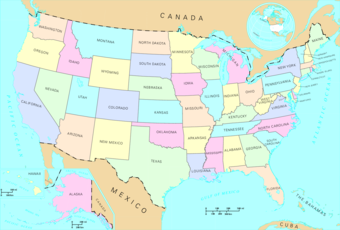
The United States
Americans live in a federal system of 50 states that, together, make up the United Sates of America.
Theories of the State
Most political theories of the state can roughly be classified into two categories. The first, which includes liberal or conservative theories, treats capitalism as a given, and concentrates on the function of states in a capitalist society. Theories of this variety view the state as a neutral entity distinct from both society and the economy.
Marxist Theory
Marxist theory, on the other hand, sees politics as intimately intermingled with economic relations, and emphasizes the relationship between economic power and political power. Marxists view the state as a partisan instrument that primarily serves the interests of the upper class. Marx and Engels were clear that communism’s goal was a classless society in which the state would have “withered away. ” For Marxist theorists, the role of the non-socialist state is determined by its function in the global capitalist order. Marx’s early writings portrayed the state as “parasitic,” built upon the superstructure of the economy and working against the public interest. He believed that the state mirrored societal class relations, that it regulated and repressed class struggle, and that it was a tool of political power and domination for the ruling class.
Anarchism
Anarchism is a political philosophy that considers states immoral and instead promotes a stateless society, anarchy. Anarchists believe that the state is inherently an instrument of domination and repression, no matter who is in control of it. Anarchists believe that the state apparatus should be completely dismantled and an alternative set of social relations created, which would be unrelated to state power.
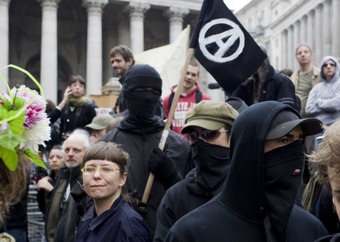
Anarchists at the G20 Summit in London, 2009
Anarchists oppose state control.
Pluralism
Pluralists view society as a collection of individuals and groups competing for political power. They then view the state as a neutral body that simply enacts the will of whichever group dominates the electoral process. Within the pluralist tradition, Robert Dahl developed the theory of the state as a neutral arena for contending interests. He also viewed governmental agencies as simply another set of competing interest groups. The pluralist approach suggests that the modern democratic state acts in response to pressures that are applied by a variety of organized interests. Dahl called this kind of state a polyarchy. Pluralism has been challenged on the ground that it is not supported by empirical evidence.
15.2.2: Characteristics of the State
A state is an organized political community acting under a government. States differ in sovereignty, governance, geography, and interests.
Learning Objective
Discuss the central characteristics that define the state
Key Points
- Federated states differ from sovereign states in that they have transferred a portion of their sovereign powers to a federal government.
- Under the rule of law, no one person can rule and even top government officials are bound by the law.
- The “nation” refers to a large geographical area and the people living there who perceive themselves as having a common identity.
- The nation state is a state that self-identifies as deriving its political legitimacy from serving as a sovereign entity for a nation as a sovereign territorial unit.
- Civil society is the arena outside of the family, the state, and the market where people associate to advance common interests.
Key Terms
- nation state
-
a political entity (a state) associated with a particular cultural entity (a nation)
- civil society
-
All of the institutions, voluntary organizations, and corporate bodies that are less than the state but greater than the family.
- Sovereign states
-
A sovereign state is a political organization with a centralized government that has supreme independent authority over a geographic area.
Example
- To understand the differences between state and nation, consider an example like Poland. The people of Poland have long formed a nation with a shared language and culture, but that nation has, through history, been cross-cut by various political borders. Thus, at times, members of the Polish nation have been governed by different states. Today, Poland’s boundaries roughly align with the geographical area where the people of the Polish nation live, and thus Poland can be thought of as a nation state.
States may be classified as sovereign if they are not dependent on, or subject to, any other power or state. Other states are subject to external sovereignty or hegemony where ultimate sovereignty lies in another state. A federated state is a territorial and constitutional community forming part of a federation. Such states differ from sovereign states, in that they have transferred a portion of their sovereign powers to a federal government.
The concept of the state is different from the concept of government. A government is the particular group of people that controls the state apparatus at a given time. In other words, governments are the means through which state power is employed; for example, by applying the rule of law. The rule of law is a legal maxim whereby governmental decisions are made by applying known legal principles. The rule of law is rule not by one person, as in an absolute monarchy, but by laws, as in a democratic republic; no one person can rule and even top government officials are under and ruled by the law.
The concept of the state is also different from the concept of a nation, which refers to a large geographical area, and the people therein who perceive themselves as having a common identity. The state is a political and geopolitical entity; the nation is a cultural or ethnic entity. The nation state is a state that self-identifies as deriving its political legitimacy from serving as a sovereign entity for a nation as a sovereign territorial unit. The term nation state implies that the two geographically coincide.
In classical thought, the state was identified with political society and civil society as a form of political community. In contrast, modern thought distinguishes the nation state as a political society from civil society as a form of economic society. Civil society is the arena outside of the family, the state, and the market where people associate to advance common interests. It is sometimes considered to include the family and the private sphere and then referred to as the third sector of society, distinct from government and business.

Heads of State
In the United States, the state is governed by a government headed by an elected president. Pictured here are, from left to right, Presidents George H.W. Bush, Barack Obama, George W. Bush, Bill Clinton, and Jimmy Carter.
15.2.3: Citizenship Rights
Citizenship carries both rights and responsibilities, as it describes a person with legal rights within a given political order.
Learning Objective
Discuss the rights and responsibilities of citizenship held by individuals
Key Points
- Citizenship is the state of being a member of a particular social, political, national, or human resource community. The term describing all citizens as a whole is citizenry.
- Citizenship generally carries with it the right of political participation in a community, including voting, participating in government, and receiving state protection.
- A person who does not have citizenship in any state is stateless.
- Many people are presumed to be citizens of a nation if they were born within the physical geographic territory of the nation. This policy is called, by the Latin legal term. jus soli, meaning “right of soil. ” A jus sanguinis policy grants citizenship based on ancestry or ethnicity.
- Nationalization is the acquisition of citizenship by somebody who was not a citizen of that country at the time of birth.
- The term “citizen of the world” has been applied to people who have fewer ties to a particular nation and more of a sense of belonging to the world in general.
Key Terms
- jus sanguinis
-
Jus sanguinis (Latin: right of blood) is a social policy by which citizenship is not determined by place of birth, but rather by having one or both parent who are citizens of the nation. It contrasts with jus soli (Latin for “right of soil”).
- jus soli
-
A right by which nationality or citizenship can be recognized to any individual born in the territory of the related state.
- nationalization
-
Nationalization is the process of taking an industry or assets into government ownership by a national government or state
Examples
- In the United States, citizens have certain rights and responsibilities, as defined in the U.S. Constitution and Bill of Rights. Citizens have the right to free speech and freedom of assembly, for example, but they also have the responsibility to follow the laws of the land and to pay taxes.
- In the United States, citizens have certain rights and responsibilities, as defined in the U.S. Constitution and Bill of Rights. Citizens have the right to free speech and freedom of assembly, for example, but they also have the responsibility to follow the laws of the land and to pay taxes.
Legally, citizenship denotes a link between an individual and a state. Under international law, citizenship is synonymous to nationality, although the two may have different meanings under national law. A person who does not have citizenship in any state is stateless.
A person is generally presumed to be a citizen of a nation if one or both of their parents are also a citizen of said nation; this is often called jus sanguinis (Latin legal term), meaning “right of blood. ” A jus sanguinis policy means grants citizenship based on ancestry or ethnicity, and is related to the concept of a nation state common in Europe. Many people are presumed to be citizens of a nation if they were born within the physical geographic territory of the nation. This policy is called by jus soli (Latin legal term), meaning “right of soil. ” These first two factors are usually lumped together under the term birthright citizenship .
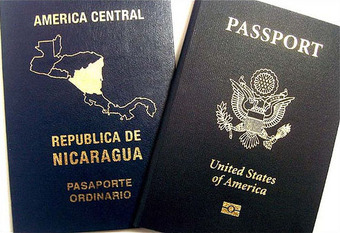
Dual Citizenship
Some people may be citizens of more than one country.
Nationalization is the acquisition of citizenship by somebody who was not a citizen of that country at the time of birth. In general, basic requirements for nationalization are that the applicant hold a legal status as a full-time resident for a minimum period of time, and that the applicant promises to obey and uphold that country’s laws, to which an oath or pledge of allegiance is sometimes added. Citizenship can also be obtained by marrying a citizen, which is termed jure matrimonii.
Citizenship status, under social contract theory, carries with it both rights and responsibilities. In this sense, citizenship was described as “a bundle of rights — primarily, political participation in the life of the community, the right to vote, and the right to receive certain protection from the community, as well as obligations. ” Citizenship is a status in society. It generally describes a person with legal rights within a given political order. It almost always has an element of exclusion, meaning that some people are not citizens; this distinction can sometimes be very important, or not important, depending on a particular society.
More generally, citizenship is seen as the relation between an individual and a particular nation. Certain entities, however, cross national boundaries, such as trade organizations, non-governmental organizations, and multi-national corporations, and sometimes the term “citizen of the world” has been applied in to people who have fewer ties to a particular nation and more of a sense of belonging to the world in general.
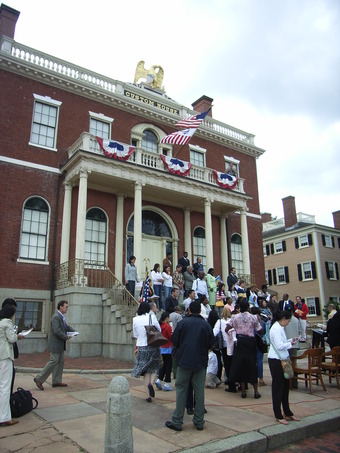
Naturalization Ceremony, Salem, MA, Citizenship Day 2007
New citizens are welcomed during a naturalization ceremony in Salem, MA.
15.2.4: State Formation
Theories explaining the origins and formation of states all revolve around the ability to centralize power in a sustainable way.
Learning Objective
Discuss the formation of states and centralization of authority in modern history
Key Points
- States first arose when agriculture and writing made centralized power possible.
- In hydraulic civilizations, water and irrigation were centrally controlled, which consequently led to the general centralization of power in a despotic state.
- According to the coercion theory of state formation, states formed in order to handle the burden of fighting and defending against wars.
- States have continued to grow more rational and bureaucratic, with expanding executive bureaucracies, such as the extensive cabinet system in the United States. Thus, states have evolved from relatively simple but powerful central powers to complex and highly organized institutions.
Key Terms
- Centralization of power
-
Centralization of power occurs in governments in which power or legal authority is exerted or coordinated by a de facto political executive to which federal states, local authorities, and smaller units are considered subject. In a national context, centralization occurs in the transfer of power to a typically sovereign nation state.
- Hydraulic civilization
-
A hydraulic empire (also known as a hydraulic despotism, or water monopoly empire) is a social or government structure which maintains power and control through exclusive control over access to water. It arises through the need for flood control and irrigation, which requires central coordination and a specialized bureaucracy.
State Formation and the Centralization of Power
Today we take it for granted that different societies are governed by different states, but this has not always been the case. Since the late nineteeth century, virtually the entirety of the world’s inhabitable land has been parceled up into areas with more or less definite borders claimed by various states. Earlier, quite large land areas had been either unclaimed or uninhabited, or inhabited by nomadic peoples who were not organized as states. In fact, for most of human history, people have lived in stateless societies, characterized by a lack of concentrated authority, and the absence of large inequalities in economic and political power.
The first known states were created in Ancient Egypt, Mesopotamia, India, China, the Americas (e.g., Aztec civilization, Inca civilization). Most agree that the earliest states emerged when agriculture and writing made it possible to centralize power in a durable way. Agriculture allowed communities to settle and also led to class division: some people devoted all their time to food production, while others were freed to specialize in other activities, such as writing or ruling. Thus, states, as an institution, were a social invention. Political sociologists continue to debate the origins of the state and the processes of state formation.
Competing Theories of State Formation
Hydraulic Civilization
According to one early theory of state formation, the centralized state was developed to administer large public works systems (such as irrigation systems) and to regulate complex economies. This theory was articulated by German American historian Karl August Wittfogel in his book 1957 Oriental Despotis. Wittfogel argued that most of the earliest states were formed in hydraulic civilizations, by which he meant civilizations where leaders controlled people by controlling the water supply. Often, these civilizations relied on complex irrigation systems that had to be centrally managed. The people, therefore, had good reason to give control to a central state, but in giving up control over the irrigation system, they also gave up control over their own livelihoods and, thus, the central state gained immense control over people in general. Although Wittfogel’s theory is well known, it has also been criticized as inaccurate. Modern archaeological and anthropological evidence shows that many early societies were not as centralized, despotic, or unequal as the hydraulic theory would suggest.
Coercion, War, and the State
An alternative theory of state formation focuses on the rise of more modern nation-states and explains their rise by arguing they became necessary for leveraging the resources necessary to fight and defend against wars. Sociologist Charles Tilly is the best known theorist in this tradition. Tilly examined political, social, and technological change in Europe from the Middle Ages to the present and attempted to explain the unprecedented success of the nation-state as the dominant form of state on Earth. In other words, instead of asking (like Wittfogel) where the very first states came from, Tilly asked where the types of states with which we’re most familiar came from, and why they became so common.
According to Tilly’s theory, military innovation in pre-modern Europe (especially gunpowder and mass armies) made war extremely expensive. As a result, only states with a sufficient amount of capital and a large population could afford to pay for their security and ultimately survive in the hostile environment. Thus, the modern states and its institutions (such as taxes) were created to enable war making.
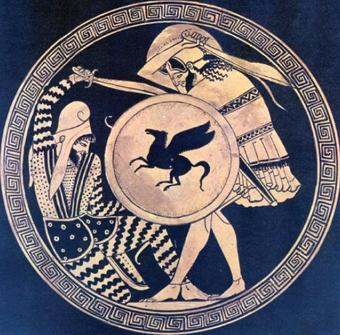
Ancient Persian and Greek Warriors
States may have formed to help societies organize for war.
Rationalization and Bureaucracy
Yet another theory of state formation focuses on the long, slow, process of rationalization and bureaucratization that began with the invention of writing. The Greeks were the first people known to have explicitly formulated a political philosophy of the state, and to have rationally analyzed political institutions. In Medieval Europe, feudalism furthered the rationalization and formalization of the state. Feudalism was based on the relationship between lord and vassal, which became central to social organization and, indeed to state organization. The Medieval state was organized by Estates, or parliaments in which key social groups negotiated with the king about legal and economic matters. Since then, states have continued to grow more rational and bureaucratic, with expanding executive bureaucracies, such as the extensive cabinet system in the United States. Thus, states have evolved from relatively simple but powerful central powers to complex and highly organized institutions.
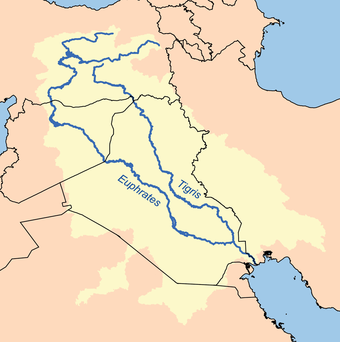
The Tigris-Euphrates Watershed in Mesopotamia
In hydraulic civilizations, control over water concentrated power in central despotic states.
15.3: Types of States
15.3.1: Types of States
States vary based on who holds power, who elects the empowered, and how authority is maintained.
Learning Objective
Identify the central features that distinguish different types of states
Key Points
- One way to classify these governments is by looking at how leaders gain power. Under this system, governments fall into general categories of authoritarianism, oligarchy, and democracy.
- Authoritarian governments differ in who holds power and in how much control they assume over those that they govern, but all are marked by the fact that the empowered are unelected individuals. One well-known example of this type of government is a monarchy.
- An oligarchy is a form of government in which power effectively rests with a small elite segment of society distinguished by royalty, wealth, family, military, or religious hegemony. One common example is theocracy.
- Democracy is a form of government in which the right to govern is held by the majority of citizens within a country or a state. All members of the society have equal access to power and all members enjoy universally recognized freedoms and liberties.
Key Terms
- theocracy
-
Government under the control of a Church or state-sponsored religion
- Democratic presidential republic
-
A system of government where an executive branch is led by a president who serves as both head of state and head of government; in such a system, this branch exists separately from the legislature, to which it is not responsible and which it cannot, in normal circumstances, dismiss.
- oligarchy
-
A government run by only a few, often the wealthy
Examples
- The United States is a democratic presidential republic.
- In the 19th century, Britain, which was a monarchy, concentrated all power in an individual king.
States come in a variety of forms that vary based on who holds power, how positions of leadership are obtained, and how authority is maintained. The United States is a democratic presidential republic: a democratic government headed by a powerful elected executive, the president. The United States originally won its independence from Britain, which was a monarchy, in which power was concentrated in an individual king. Other forms of government include oligarchy and dictatorship or totalitarianism. One way to classify these governments is by looking at how leaders gain power. Under this system, governments fall into general categories of authoritarianism, oligarchy, and democracy.
Authoritarian Governments
Authoritarian governments differ in who holds power and in how much control they assume over those that they govern, but all are marked by the fact that the empowered are unelected individuals. One well-known example of this type of government is a monarchy.
A monarchy is a form of government in which supreme power is absolutely or nominally lodged with an individual, who is the head of state, often for life or until abdication. The person who heads a monarchy is called a monarch. There is no clear definition of monarchy. Some monarchs hold unlimited political power while many constitutional monarchies, such as the United Kingdom and Thailand, have monarchs with limited political power. Hereditary rule is often a common characteristic, but elective monarchies are also considered monarchies (e.g., The Pope) and some states have hereditary rulers, but are considered republics (e.g., the Dutch Republic). Currently, 44 nations in the world have monarchs as heads of state.
Totalitarianism (or totalitarian rule) is a political system that strives to regulate nearly every aspect of public and private life. Totalitarian regimes or movements maintain themselves in political power by means of an official all-embracing ideology and propaganda disseminated through the state-controlled mass media, a single party that controls the state, personality cults, control over the economy, regulation and restriction of free discussion and criticism, the use of mass surveillance, and widespread use of state terrorism.
Oligarchic Governments
An oligarchy is a form of government in which power effectively rests with a small elite segment of society distinguished by royalty, wealth, family, military, or religious hegemony. An oligarchy is different from a true democracy because very few people are given the chance to change things. An oligarchy does not have to be hereditary or monarchic. An oligarchy does not have one clear ruler, but several powerful people who rule. One common example is that of theocracy.
Theocracy is a form of government in which a god or deity is recognized as the state’s supreme civil ruler, or in a broader sense, a form of government in which a state is governed by immediate divine guidance or by officials who are regarded as divinely guided. Theocratic governments enact theonomic laws. Theocracies are distinguished from other secular forms of government that have a state religion, or are merely influenced by theological or moral concepts, and monarchies held “by the Grace of God. “
Democratic Governments
Democracy is a form of government in which the right to govern is held by the majority of citizens within a country or a state. The two principles of a democracy are that all citizens have equal access to power and that all citizens enjoy universally recognized freedoms and liberties. There are several varieties of democracy, some of which provide better representation and more freedoms for their citizens than others. However, if any democracy is not carefully legislated with balances, such as the separation of powers, to avoid an uneven distribution of political power, then a branch of the system of rule could accumulate power and become harmful to the democracy itself. Freedom of political expression, freedom of speech, and freedom of the press are essential so that citizens are informed and able to vote in their personal interests.

Countries of the World, by Type of Government in 2011
This map shows all the countries of the word, colored according to their type of government. Blue represents full presidential republics, while green and yellow are presidential republics with less powerful presidents. Orange represents parliamentary republics. Red and pink are parliamentary constitutional monarchies, and purple represents absolute monarchies. Brown represents single-party republics, green shows countries where government has been suspended (e.g., military dictatorships), and grey countries do not fit any of the above categories.
15.3.2: Monarchy
A monarchy is a form of government in which supreme power is absolutely or nominally lodged with an individual, who is the head of state.
Learning Objective
Give examples of monarchies in the contemporary world
Key Points
- Monarchy was a common form of government in the world during the ancient and medieval times. It is less common today, although several monarchies still exist.
- Modern monarchies often takes the form of a constitutional monarchy, in which the monarch retains a unique legal and ceremonial role, but exercises limited or no political power pursuant to a constitution or tradition which allocates governing authority elsewhere.
- Most states only have a single person acting as monarch at any given time, although two monarchs have ruled simultaneously in some countries, a situation known as diarchy.
Key Terms
- diarchy
-
A form of government where power is shared between two joint authorities.
- hereditary rule
-
Hereditary rule is a form of government in which all the rulers come from the same family, and the crown is passed down from one member to another member of the family.
Example
- Currently, 44 nations in the world have monarchs as heads of state. Of these, 16 are Commonwealth realms such as Canada and Australia that recognize the monarch of the United Kingdom as their head of state.
A monarchy is a form of government in which supreme power is absolutely or nominally lodged with an individual, who is the head of state, often for life or until abdication. The person who heads a monarchy is called a monarch.
Monarchy was the most common form of government into the 19th century, but it is no longer prevalent, at least at the national level. Monarchy now often takes the form of a constitutional monarchy, in which the monarch retains a unique legal and ceremonial role, but exercises limited or no political power pursuant to a constitution or tradition which allocates governing authority elsewhere. Currently, 44 nations in the world have monarchs as heads of state. Of these, 16 are Commonwealth realms such as Canada and Australia that recognize the monarch of the United Kingdom as their head of state.
There is no clear definition of monarchy. Even characteristics most commonly associated with monarchies are not universal. For example, monarchies are often though of as highly centralized forms of absolute power. But holding unlimited political power in the state is not the defining characteristic, as many constitutional monarchies such as the United Kingdom and Thailand are considered monarchies yet their monarchs have limited political power. Hereditary rule is often a common characteristic, but some monarchs are elected (e.g., the Pope), and some states with hereditary rulers are nevertheless considered republics (e.g., the Dutch Republic).
Most states only have a single person acting as monarch at any given time, although two monarchs have ruled simultaneously in some countries, a situation known as diarchy. Historically, this was the case in the ancient Greek city-state of Sparta or 17th-century Russia, and there are examples of joint sovereignty of spouses or relatives (such as William and Mary in the Kingdoms of England and Scotland).
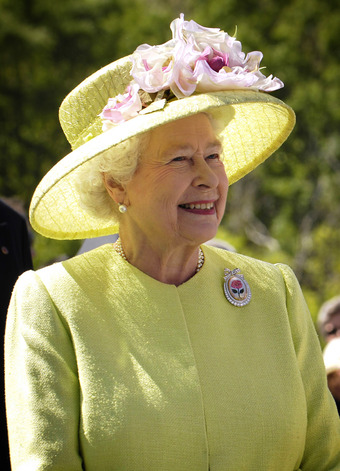
Queen Elizabeth II
Queen Elizabeth II is the monarch of the United Kingdom.
15.3.3: Oligarchy
An oligarchy is a form of government in which power effectively rests with a small elite segment of society.
Learning Objective
Compare and contrast the different types of oligarchical governments that exist
Key Points
- Like monarchies, oligarchies may depend on blood relations, but they may also depend on wealth, religion, or military hegemony.
- In de jure oligarchies, an elite group is given power by the law. For example, the law may give only nobility the right to vote, or a theocracy may be ruled by a group of religious leaders.
- In de facto oligarchies, those with more resources are able to gain political power, despite laws that ostensibly treat all citizens equally.
- Some contemporary authors have characterized the United States’ current state of affairs as being oligarchic in nature.
Key Term
- elite
-
A special group or social class of people which have a superior intellectual, social or economic status as, the elite of society.
Examples
- The Soviet Union was a de jure oligarchy: only members of the Communist Party were allowed to vote or hold office. Today, Russia may be considered a de facto oligarchy: Since the collapse of the Soviet Union on 31 December 1991, privately owned Russia-based multinational corporations, including producers of petroleum, natural gas, and metal have become oligarchs. Privatization allowed executives to amass phenomenal wealth and power almost overnight. In May 2004, the Russian edition of Forbes identified 36 of these oligarchs as being worth at least $1 billion.
- Another modern example of oligarchy could be seen in South Africa during the twentieth century. Here, the basic characteristics of oligarchy are particularly easy to observe, since the South African form of oligarchy was based on race. After the Second Boer War, a tacit agreement or understanding was reached between English- and Afrikaans-speaking whites. Together, they made up about 20 percent of the population, but this small percentage ruled the vast non-white and mixed-race population. Whites had access to virtually all the educational and trade opportunities, and they proceeded to deny this to the black majority. Although this process had been going on since the mid-17th- 18th century, after 1948 it became official government policy and became known worldwide as apartheid. This lasted until the arrival of democracy in South Africa in 1994, punctuated by the transition to a democratically-elected government dominated by the black majority.
An oligarchy is a form of government in which power effectively rests with a small elite segment of society distinguished by royalty, wealth, family, military, or religious hegemony. Oligarchies are often controlled by politically powerful families whose children are heavily conditioned and mentored to be heirs of the power of the oligarchy. These types of states have been tyrannical throughout history, relying on public servitude and complacency in order to exist.
States may be oligarchies de jure or de facto. In de jure oligarchies, an elite group is given power by the law. The law may give only nobility the right to vote, or a theocracy may be ruled by a group of religious leaders. In de facto oligarchies, those with more resources are able to gain political power, despite laws that ostensibly treat all citizens equally. One example of this is a corporate oligarchy, or corporatocracy—a system in which power effectively rests with a small, elite group of inside individuals, sometimes from a small group of educational institutions, or influential economic entities or devices, such as banks, commercial entities, lobbyists that act in complicity with, or at the whim of the oligarchy, often with little or no regard for constitutionally protected prerogative. Monopolies are sometimes granted to state-controlled entities, such as the Royal Charter granted to the East India Company, or privileged bargaining rights to unions (labor monopolies) with very partisan political interests. Today’s multinational corporations function as corporate oligarchies with influence over democratically elected officials.
Some contemporary authors have characterized the United States’ current state of affairs as being oligarchic in nature. Jeffrey A. Winters argues that “oligarchy and democracy operate within a single system, and American politics is a daily display of their interplay. ” Bernie Sanders (I-VT) opined in a 2010 article from The Nation that an “upper-crust of extremely wealthy families are hell-bent on destroying the democratic vision of a strong middle-class which has made the United States the envy of the world. In its place they are determined to create an oligarchy in which a small number of families control the economic and political life of our country. “
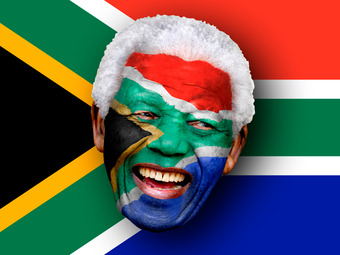
Nelson Mandela
In 1994, Nelson Mandela became the first president of South Africa elected in a fully representative election, which marked the end of oligarchic apartheid in that country.
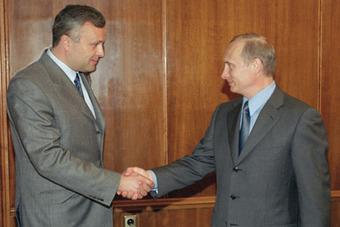
Alexander Lebedev and President Putin
Alexander Lebedev represents a new class of Russian oligarchs, which arose after the fall of communism by taking control of major industries. He is one of the richest people in the world.
15.3.4: Dictatorship and Totalitarianism
Dictatorships govern without consent of the people and in totalitarian dictatorships the power to govern extends to all aspects of life.
Learning Objective
Compare and contrast dictatorships with totalitarian governments
Key Points
- Dictatorship is a form of government in which the ruler has the power to govern without consent of those being governed.
- Totalitarian governments are those that regulate nearly every aspect of public and private behavior.
- Dictatorship concerns the source of the governing power (where the power comes from, the people or a single leader) and totalitarianism concerns the scope of the governing power (what is the government and how extensive is its power).
Key Terms
- dictatorship
-
A type of government where absolute sovereignty is allotted to an individual or a small clique.
- totalitarianism
-
A system of government in which the people have virtually no authority and the state wields absolute control, for example, a dictatorship.
Example
- Nazi Germany may be the most familiar example of a totalitarian dictatorship. Under the Nazi regime, Hitler was a dictator who governed without the consent of the people and he led a totalitarian government that regulated all aspects of daily life and exerted immense control over its subjects.
Dictatorship and totalitarianism are often associated, but they are actually two separate phenomena. Dictatorship is a form of government in which the ruler has the power to govern without consent of those being governed. Dictatorship can also be defined simply as “a system that does not adhere to democracy,” where democracy is defined as a form of government where those who govern are selected through contested elections. A dictator’s power can originate in his or her family, political position, or military authority.
Many dictatorships are also totalitarian. Totalitarian governments are those that exert total control over the governed; they regulate nearly every aspect of public and private behavior. Totalitarianism entails a political system where the state recognizes no limits to its authority, and it strives to regulate every aspect of public and private life wherever feasible. Totalitarian regimes stay in political power through all-encompassing propaganda campaigns (disseminated through the state-controlled mass media), a single party that is often marked by political repression, personality cultism, control over the economy, regulation and restriction of speech, mass surveillance, and widespread use of terror.
In other words, dictatorship concerns the source of the governing power (where the power comes from—the people or a single leader) and totalitarianism concerns the scope of the governing power (what is the government and how extensive is its power). In this sense, dictatorship (government without people’s consent) exists in contrast with democracy (government whose power comes from people) and totalitarianism (where government controls every aspect of people’s lives) exists in contrast with pluralism (where government allows multiple lifestyles and opinions) .
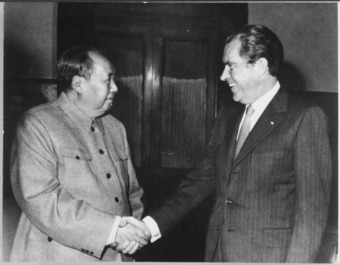
President Nixon and Mao Zedong, 1972
In 1972, Nixon traveled to China and met with Mao Zedong, the leader of the totalitarian Chinese Communist Party.
15.3.5: Democracy
Democracy is a form of government in which sovereignty is held by the majority of citizens within a country or a state.
Learning Objective
Discuss the central features of democratic governments
Key Points
- Democracies come in several forms, though all have competitive elections and freedoms of expression.
- Democracies must balance conflicting obligations to try to maximize freedom and protect individual rights.
- In most democracies, citizens are represented by elected lawmakers charged with drafting and voting on laws.
Key Terms
- separation of powers
-
A theoretical model for governance, common in democratic states, which features the division of sovereign power into at least three (but sometimes up to six) organs of state in order to forestall tyranny, by preventing the acquisition of a monopoly of power by a monarch or oligarchy; also, such an arrangement.
- representative democracy
-
A policy under the rule of people acting on the behalf of and, to a lesser extent, in the interests of the voting blocks by which they were elected.
- tyranny of the majority
-
A situation in which a government or other authority democratically supported by a majority of its subjects makes policies or takes actions benefiting that majority, without regard for the rights or welfare of the rest of its subjects.
Examples
- The United States is an example of a representative democracy. Citizens over the age of 18 may vote in elections to choose their representatives. Those representatives serve in local, state, and national governments. For example, at the local level, citizens elect mayors; at the state level, they elect governors and state legislators; and at the national level, they elect the president, representatives, and senators.
- The United States also provides historical examples of the tyranny of the majority. For example, until 1967, some states outlawed interracial marriage. Such laws embodied majority opinion, at least at the time the law was made, but were oppressive to a minority of citizens who opposed the law. Democracy can make such laws difficult to change until majority sentiment shifts–in this case, after the Civil Rights era of the 1960s.
Democracy is a form of government in which the power of government comes from the people. More formally, we might say that in democracy, the right to govern, or sovereignty, is held by the majority of citizens within a country or state. Even though there is no universally accepted definition of democracy, all definitions include two fundamental principles: First, in a democracy, all citizens have equal access to power. Second, all citizens enjoy universally recognized freedoms and liberties.
Democracies come in several forms, some of which provide better representation and more freedoms for their citizens than others. An essential process in representative democracies is competitive elections that are fair both substantively and procedurally. Furthermore, freedom of political expression, freedom of speech, and freedom of the press are essential so that citizens are informed and able to vote in their personal interests.
Democracies must balance conflicting obligations to try to maximize freedom and protect individual rights. For example, many democracies limit representation. In a full, direct, democracy, every citizen would be able to vote on every law. But in reality, in most democracies, citizens are represented by elected lawmakers charged with drafting and voting on laws. Many also institute measures such as the separation of powers, which divides executive, judicial, and legislative authority among different branches of government to protect against the possibility that a single government or branch of government could accumulate too much power and become harmful to democracy itself. Although such measures may limit representation, they make lawmaking more efficient and help guard against dangers such as the tyranny of the majority. Although majority rule is often described as a characteristic feature of democracy, without responsible government it is possible for the rights of a minority to be abused by the tyranny of the majority, in which a majority institutes policies abusive to a minority (for example, a racial majority may deny a racial minority access to education, housing, jobs, or other resources).
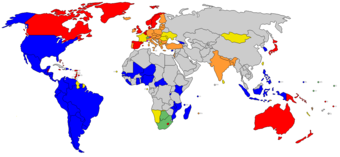
Electoral Democracies
This map depicts electoral democracies around the world, as judged by Freedom House in 2006. Different colors indicate different forms of democracy. Orange countries are parliamentary republics. Green, yellow, and blue are presidential republics with less (green) or more (blue) presidential power. Red are parliamentary constitutional monarchies in which the monarch does not personally exercise power.
15.3.6: New State Spaces
States are not necessarily the same as nations. New state spaces are redefining borders, and they may not be ruled by national governments.
Learning Objective
Explain how political boundaries are changing due to globalization
Key Points
- A global city is a city that is central to the global economic or cultural system, such as New York or London.
- Not only are global cities important economically, but they are also politically unique. In some ways, global cities are more intimately connected to the global economic system and to other global cities than they are to surrounding regions or national settings.
- Another example of a new state space is seen in regional and international governments such as the European Union.
- State power is not restricted to the national level. New state spaces are evolving at both the local level (global cities) and the international level (the European Union).
Key Terms
- European Union
-
A supranational organization created in the 1950s to bring the nations of Europe into closer economic and political connection. At the beginning of 2007, 27 member nations were Austria, Belgium, Bulgaria, Cyprus, Czech Republic, Denmark, Estonia, Finland, France, Germany, Greece, Hungary, Ireland, Italy, Latvia, Lithuania, Luxembourg, Malta, The Netherlands, Poland, Portugal, Romania, Slovakia, Slovenia, Spain, Sweden, United Kingdom.
- Global city
-
A global city (also called world city or sometimes alpha city or world center) is a city generally considered to be an important node in the global economic system.
- Political borders
-
A border is a geographical boundary of political entities or legal jurisdictions.
Examples
- New York and London are examples of global cities that command vast political, economic, and cultural influence both domestically and internationally.
- Another example of a new state space is the European Union, a confederation of 27 European states that encourages political and economic cooperation among its members.
For the last couple centuries, states have been largely coterminous with nations: the two tend to overlap. But states are not necessary the same as nations, and state boundaries will not necessarily always be the same as national boundaries. Recent sociological work has argued that, with globalization, relevant political borders are changing. This branch of sociology defines new state spaces as geographical spaces that are not governed simply by national governments. Instead, they may be more directly influenced by local, regional, or even international governmental bodies. One of the most prominent theories in this field is that of global cities.
Global Cities
A global city is a city that is central to the global economic system, such as New York or London. According to global cities theory, globalization is not a process that affects all places evenly. Globalization is carried out by certain cities, which can be arranged in a hierarchy of importance. Some of these cities are absolutely central to the operation of the global economic system, and some are more peripheral. The most complex and central cities are known as global cities.
Not only are global cities important economically, but they are also politically unique. In some ways, global cities are more intimately connected to the global economic system and to other global cities than they are to surrounding regions or national settings. In general, global cities tend to actively influence and participate in international effents and world affairs. They may be national capitals, or they may host the headquarters of international organizations such as the World Bank, NATO, or the UN. They also tend to have large expatriate communities, groups of people from other countries, who give the cities a cosmpolitan flair and also increase the relevance of foreign political events for global cities.
Regional and International Government
Another example of a new state space is seen in regional and international governments such as the European Union. The European Union is a confederation of 27 European states. It was originally formed to encourage and enable economic cooperation, but has grown to have a good deal of political power, most notably directing a Common Agricultural Policy for member states. Thus, citizens of European countries are governed not only by local and national states, but also by the European Union.
State power is not restricted to the national level. New state spaces are evolving at both the local level (global cities) and the international level (the European Union).
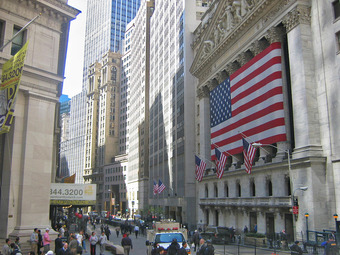
New York Stock Exchange – Wall Street
New York is global city, central to the global economy.
15.4: Democracy
15.4.1: Democracy
Democracy is an egalitarian form of government in which all the citizens of a nation together determine policy, laws, and state actions.
Learning Objective
Discuss the definition of democracy: its core qualities, and any controversy over those qualities
Key Points
- The most common system that is deemed democratic in the modern world is parliamentary democracy in which the voting public takes part in elections and chooses politicians to represent them in a legislative assembly.
- A purer form is direct democracy in which the voting public makes direct decisions or participates directly in the political process.
- Elements considered essential to democracy include freedom of political expression, freedom of speech, and freedom of the press, so that citizens are adequately informed and able to vote according to their own best interests as they see them.
- Majority rule is often listed as a characteristic of democracy. However, it is also possible for a minority to be oppressed by a tyranny of the majority in the absence of governmental or constitutional protections of individual or group rights.
Key Terms
- egalitarian
-
Characterized by social equality and equal rights for all people.
- civil society
-
All of the institutions, voluntary organizations, and corporate bodies that are less than the state but greater than the family.
- Parliament
-
A democratic government’s legislature.
Examples
- In a representative democracy, every vote has equal weight, no unreasonable restrictions can apply to anyone seeking to become a representative, and the freedom of its citizens is secured by legitimized rights and liberties which are generally protected by a constitution.
- In the United States, separation of powers is often cited as a central attribute, but in other countries, such as the United Kingdom, the dominant principle is that of parliamentary sovereignty (while maintaining judicial independence).
Democracy is an egalitarian form of government in which all the citizens of a nation together determine public policy, the laws, and the actions of their state. It requires that all citizens (meeting certain qualifications) have an equal opportunity to express their opinion. In practice, democracy is the extent to which a given system approximates this ideal. A given political system is referred to as a democracy if it allows a certain approximation to ideal democracy. Although no country has ever granted all its citizens (i.e. including minors) the vote, most countries today hold regular elections based on egalitarian principles, at least in theory.
The most common system that is deemed democratic in the modern world is parliamentary democracy in which the voting public takes part in elections and chooses politicians to represent them in a legislative assembly. The members of the assembly then make decisions with a majority vote. A purer form is direct democracy in which the voting public makes direct decisions or participates directly in the political process. Elements of direct democracy exist on a local level and in exceptions on the national level in many countries, although these systems coexist with representative assemblies.
The term democracy comes from the Greek word δ (dēmokratía), “rule of the people,” which was coined from δ (dēmos), “people,” and κ (kratia), “rule,” in the middle of the 5th-4th century BCE to denote the political systems then existing in some Greek city-states, notably Athens following a popular uprising in 508 BCE. Other cultures since Greece have significantly contributed to the evolution of democracy, such as Ancient Rome, Europe, and North and South America. The concept of representative democracy arose largely from ideas and institutions that developed during the European Middle Ages and the Age of Enlightenment and in the American and French Revolutions. The right to vote has been expanded in many jurisdictions over time from relatively narrow groups (such as wealthy men of a particular ethnic group), with New Zealand the first nation to grant universal suffrage for all its citizens in 1893.
Elements considered essential to democracy include freedom of political expression, freedom of speech, and freedom of the press, so that citizens are adequately informed and able to vote according to their own best interests as they see them. The term “democracy” is often used as shorthand for liberal democracy, which may include elements such as political pluralism, equality before the law, the right to petition elected officials for redress of grievances, due process, civil liberties, human rights, and elements of civil society outside the government. Democracy is often confused with the republic form of government. In some definitions of republic, a republic is a form of democracy. Other definitions make republic a separate, unrelated term.
While there is no universally accepted definition of democracy, equality and freedom have both been identified as important characteristics of democracy since ancient times. These principles are reflected in all citizens being equal before the law and having equal access to legislative processes. For example, in a representative democracy, every vote has equal weight, no unreasonable restrictions can apply to anyone seeking to become a representative, and the freedom of its citizens is secured by legitimized rights and liberties which are generally protected by a constitution.
According to some theories of democracy, popular sovereignty is the founding principle of such a system. However, the democratic principle has also been expressed as “the freedom to call something into being which did not exist before, which was not given … and which therefore, strictly speaking, could not be known. ” This type of freedom, which is connected to human natality, or the capacity to begin anew, sees democracy as “not only a political system… [but] an ideal, an aspiration, really, intimately connected to and dependent upon a picture of what it is to be human—of what it is a human should be to be fully human. “
In the United States, separation of powers is often cited as a central attribute, but in other countries, such as the United Kingdom, the dominant principle is that of parliamentary sovereignty (whilst maintaining judicial independence). In other cases, democracy is used to mean direct democracy. Though the term “democracy” is typically used in the context of a political state, the principles are applicable to private organizations and other groups as well.
Majority rule is often listed as a characteristic of democracy. However, it is also possible for a minority to be oppressed by a tyranny of the majority in the absence of governmental or constitutional protections of individual or group rights. An essential part of an ideal representative democracy is competitive elections that are fair both substantively and procedurally.
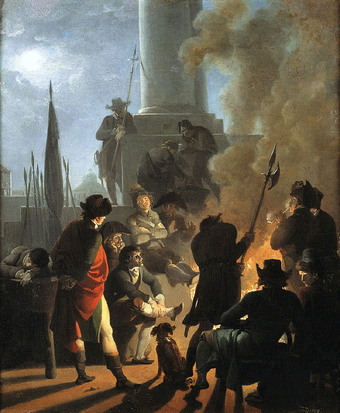
The French Revolution and the Birth of Democracy
This painting, called Le bivouac des sans-coulottes, depicts a scene from the French Revolution, which ushered in democracy in France.
15.4.2: Participatory Democracy
Participatory democracy emphasized the broad participation of constituents in the direction and operation of political systems.
Learning Objective
List the key qualities of participatory democracy and some of its historical manifestations
Key Points
- Participatory democracy tends to advocate more involved forms of citizen participation than traditional representative democracy.
- Participatory democracy strives to create opportunities for all members of a population to make meaningful contributions to decision making, and seeks to broaden the range of people who have access to such opportunities.
- In 8th and 7th century Ancient Greece, the informal distributed power structure of the villages and minor towns began to be displaced with collectives of Oligarchs seizing power as the villages and towns coalesced into city states.
- Deliberative democracy differs from traditional democratic theory in that authentic deliberation, not mere voting, is the primary source of a law’s legitimacy.
- Demarchy is a hypothetical system where government is heavily decentralized into smaller independent groups and where randomly selected decision makers have been chosen to govern, and each group is responsible for one or several functions in society.
- Deliberative democracy differs from traditional democratic theory in that authentic deliberation, not mere voting, is the primary source of a law’s legitimacy.
- Demarchy is a hypothetical system where government is heavily decentralized into smaller independent groups. Each group is responsible for one or several functions in society.
Key Terms
- deliberative democracy
-
Deliberative democracy or discursive democracy is a form of democracy in which deliberation is central to decision making. Deliberative democracy differs from traditional democratic theory in that authentic deliberation, not mere voting, is the primary source of legitimacy for the lawmaking processes.
- Demarchy
-
Demarchy (or lottocracy) is a form of government in which the state is governed by randomly selected decision makers who have been selected by sortition (lot) from a broadly inclusive pool of eligible citizens.
- Occupy movement
-
The Occupy movement is an international protest movement against social and economic inequality; its primary goal is to to make economic structure and power relations in society more fair.
Example
- In the United States, many states and local communities have tried to reinvigorate participatory democracy by introducing novel types of ballot initiatives. An initiative or proposition is begun by a group of interested citizens who gather support for a measure they would like to put to a popular vote. Usually, they must gather a certain number of signatures to show that the initiative has enough support to give it a chance in an election. If they gather enough signatures, the initiative will appear on a ballot and be put to a popular vote. Through this process, laws can be made by direct vote rather than by elected representatives in a legislature. One recent example of a ballot initiative was Proposition 8 in California in 2008, which was passed by the people and banned same-sex marriage in the state (until it was overturned by the court).
Participatory democracy is a process emphasizing the broad participation of constituents in the direction and operation of political systems. The etymological roots of democracy (Greek demos and kratos) imply that the people are in power and, thus, that all democracies are participatory. However, participatory democracy tends to advocate more involved forms of citizen participation than traditional representative democracy. Participatory democracy strives to create opportunities for all members of a population to make meaningful contributions to decision making and seeks to broaden the range of people who have access to such opportunities.
Participatory democracy has been a feature of human society since at least classical times. It is believed to have been a common practice of undeveloped people and hunter-gatherer tribes. In seventh and eighth century ancient Greece, the informal distributed power structure of the villages and minor towns began to be displaced with collectives of oligarchs seizing power as the villages and towns coalesced into city-states. A brief period where a region was governed almost totally by participatory democracy occurred during the Spanish civil war, from 1936-1938, in the parts of Spain controlled by anarchist Republicans. In the 1960s, the promotion and use of participatory democracy was a major theme for elements of the American Left. In 2011, participatory democracy became a notable feature of the Occupy movement, with Occupy camps around the world making decisions based on the outcome of working groups where every protestor gets to have his say, and by general assemblies where the decisions taken by working groups are effectively aggregated together .
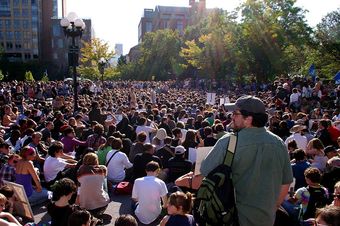
Occupy Wall Street, Washington Square Park 2011
The Occupy Wall Street General Assembly meets in Washington Square Park for the first time on Saturday, October 8.
Political variants of participatory democracy include consensus democracy, deliberative democracy, demarchy, and grassroots democracy. Deliberative democracy differs from traditional democratic theory in that authentic deliberation, not mere voting, is the primary source of a law’s legitimacy. It adopts elements of both consensus decision making and majority rule. When practiced by small groups, it is possible for decision making to be both fully participatory and deliberative. But for large political entities, the democratic reform dilemma makes it difficult for any system of decision making based on political equality to involve both deliberation and inclusive participation. Demarchy is a hypothetical system where government is heavily decentralized into smaller independent groups and where randomly selected decision makers have been chosen to govern, and each group is responsible for one or several functions in society. The system seeks to avoid problems with centralized and electoral governance, while still providing a stable democratic system.
Some scholars argue for refocusing the term on community-based activity within the domain of civil society, based on the belief that a strong non-governmental public sphere is a precondition for the emergence of a strong liberal democracy.
15.4.3: Monarchies and Liberal Democracies
Monarchies, in which sovereignty embodied in a single individual, eventually gave way to liberal democracies.
Learning Objective
Distinguish between an absolute monarchy and a constitutional monarchy
Key Points
- When the monarch has no or few legal restraints in state and political matters, it is called an absolute monarchy and is a form of autocracy.
- Monarchies are associated with political or sociocultural hereditary rule, in which monarchs rule for life (although some monarchs do not hold lifetime positions).
- An absolute monarchy refers to when the monarch has no or few legal restraints in state and political matters.
- In a constitutional monarchy, the monarch retains a unique legal and ceremonial role.
- Throughout history, monarchies have been abolished, either through revolutions, legislative reforms, coups d’état, or wars.
- Liberal democracy traces its origins—and its name—to the European 18th century, also known as the Age of Enlightenment.
Key Terms
- absolute monarchy
-
A state over which a sole monarch has absolute and unlimited power.
- constitutional monarchy
-
A monarchy in which the monarch’s power is limited by a written constitution.
- Enlightenment
-
A 17th and 18th-century philosophical movement in European history; the Age of Enlightenment or Age of Reason emphasizing rationalism.
Example
- Currently, 44 sovereign nations in the world have monarchs acting as heads of state, 16 of which are Commonwealth realms that recognize Queen Elizabeth II of England as their head of state.
A monarchy is a form of government in which sovereignty is actually or nominally embodied in a single individual, the monarch. A monarch that has few or no legal restraints in state and political matters is referred to as an absolute monarchy, a form of autocracy. Monarchies are associated with political or sociocultural hereditary rule, in which monarchs rule for life (although some monarchs do not hold lifetime positions). Throughout history, monarchies have been abolished, either through revolutions, legislative reforms, coups d’état or wars. The twentieth century saw a major escalation of this process, with many monarchies violently overthrown by revolution or war, or abolished as part of the process of decolonization. The 21st century has already seen several monarchies abolished, usually by peaceful means in a referendum.
Monarchy was the most common form of government into the 19th century, but it is no longer prevalent, at least at the national level. Where it exists, it now often takes the form of constitutional monarchy, in which the monarch retains a unique legal and ceremonial role, but exercises limited or no political power pursuant to a constitution or tradition which allocates governing authority elsewhere. Currently, 44 sovereign nations in the world have monarchs acting as heads of state—16 of those are Commonwealth realms that recognize Queen Elizabeth II as their head of state.
Liberal democracy traces its origins, and its name, to the European 18th century, also known as the Age of Enlightenment. At the time, the vast majority of European states were monarchies, with political power held either by the monarch or the aristocracy. Near the end of the 18th century, these ideas inspired the American and French Revolutions, the latter giving birth to the ideology of liberalism, and instituting forms of government that attempted to apply the principles of the Enlightenment philosophers into practice. Reforms and revolutions helped move most European countries towards liberal democracy. Liberalism ceased being a fringe opinion and joined the political mainstream.
15.4.4: The Spread of Liberal Democracy
Liberal democracy requires universal suffrage, competitive politics, and the rule of law and is currently the dominant world political ideology.
Learning Objective
Defend the notion of liberal democracy using examples from its enlightenment origins
Key Points
- Liberal democracy is a common form of representative democracy.
- According to the principles of liberal democracy, elections should be free and fair, with the presence of multiple and distinct political parties.
- The liberal democracies usually have universal suffrage, granting all adult citizens the right to vote regardless of race, gender, or property ownership.
- Liberal democracy traces its origins to the European 18th century, also known as the Age of Enlightenment.
- The Enlightenment intellectuals believed that human affairs should be guided by reason and principles of liberty and equality. They were opposed to the rule of undemocratic and illegitimate monarchies and aristocracies.
- Liberal democracies are currently the dominant form of political ideology in the modern world.
- The rule of law refers to the concept that laws should apply to those who govern as well as to the governed.
- The ideas of the Enlightenment inspired the American Revolution and the French Revolution, which gave birth to the ideology of liberalism.
- Throughout the 19th and 20th centuries, reforms and revolutions helped move most European countries towards liberal democracy.
Key Terms
- Enlightenment
-
A 17th and 18th-century philosophical movement in European history; the Age of Enlightenment or Age of Reason emphasizing rationalism.
- the rule of law
-
The rule of law is a legal maxim whereby governmental decisions are made by applying known legal principles.
- liberalism
-
Any political movement founded on the autonomy and personal freedom of the individual, progress and reform, and government by law with the consent of the governed.
Example
- The United States, Canada, France, and other Western countries are examples of liberal democracies.
Liberal democracy is a common form of representative democracy. According to the principles of liberal democracy, elections should be free and fair, with the presence of multiple and distinct political parties. Liberal democracies also usually have universal suffrage, granting all adult citizens the right to vote.
Liberal democracy traces its origins—and its name—to the European 18th century, also known as the Age of Enlightenment. At the time, the vast majority of European states were monarchies, with political power held either by the monarch or the aristocracy. The possibility of democracy had not been seriously considered in political theory since classical antiquity, and the widely held belief was that democracies would be inherently unstable and chaotic in their policies due to the changing whims of the people. It was further believed that democracy was contrary to human nature, as human beings were seen to be inherently evil, violent, and in need of a strong leader to restrain their destructive impulses.
The Enlightenment
These conventional views were first challenged by a relatively small group of Enlightenment intellectuals who believed that human affairs should be guided by reason and principles of liberty and equality. They argued that all people are created equal, and therefore political authority cannot be justified on the basis of so-called noble blood, a supposed privileged connection to God, or any other characteristic alleged to make one person superior to others. They further argued that governments exist to serve the people, not vice versa, and that laws should apply to those who govern as well as to the governed, a concept known as the rule of law.
Reform and Revolution
Near the end of the 18th century, these ideas inspired the American Revolution and the French Revolution, the pair of which gave birth to the ideology of liberalism and instituted forms of government that attempted to apply the principles of Enlightenment philosophy in practice. The dominions of the British Empire became laboratories for liberal democracy from the mid-19th century onward. In Canada, responsible government began in the 1840s and in Australia and New Zealand parliamentary government elected by male suffrage and secret ballot was established from the 1850s and female suffrage achieved from the 1890s.
Reforms and revolutions helped move most European countries towards liberal democracy. Liberalism ceased to be a fringe opinion and joined the political mainstream. The political spectrum changed; traditional monarchy became more and more a fringe view and liberal democracy became more and more mainstream. By the end of the 19th century, liberal democracy was no longer only a liberal idea, but an idea supported by many different ideologies. After World War I and especially after World War II, liberal democracy achieved a dominant position among theories of government and is now endorsed by the vast majority of the political spectrum.
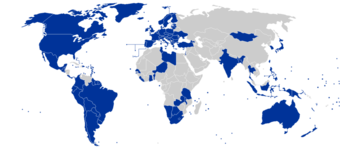
Electoral Democracies
Countries highlighted in blue are designated “electoral democracies” in Freedom House’s 2010 survey Freedom in the World.
15.4.5: Democracy in the U.S.
The United States is a federal constitutional republic in which the federal government shares sovereignty with the state governments.
Learning Objective
Diagram the basic form of the United States government, focusing on its branches and electoral system
Key Points
- The executive branch is headed by the President and is independent of the legislature.
- Legislative power is vested in the two chambers of Congress, the Senate and the House of Representatives.
- The Judicial branch, which is composed of the Supreme Court and lower federal courts, exercises judicial power.
- Suffrage is nearly universal for citizens 18 years of age and older.
- On a national level, the President is elected indirectly by the people through an Electoral College.
- The modern political party system in the United States is a two-party system dominated by the Democratic Party and the Republican Party.
- Special interest groups advocate the cause of their specific constituency.
Key Terms
- legislative power
-
Legislative power refers to the power of a legislature, or deliberative assembly to pass, amend and repeal laws.
- electoral college
-
The Electoral College consists of individual state appointed electors who formally elect the President and Vice President of the United States.
- suffrage
-
The right or chance to vote, express an opinion or participate in a decision.
Example
- In the United States, suffrage is nearly universal for citizens 18 years of age and older.
The United States is a federal constitutional republic in which the President of the United States (the head of state and government), Congress, and judiciary share powers reserved to the national government, and the federal government shares sovereignty with the state governments. The executive branch is headed by the President and is independent of the legislature.
Legislative power is vested in the two chambers of Congress, the Senate and the House of Representatives. The judicial branch, composed of the Supreme Court and lower federal courts, exercises judicial power. The judiciary’s function is to interpret the United States Constitution and federal laws and regulations. This includes resolving disputes between the executive and legislative branches. The federal government’s organization is explained in the Constitution.
In the United States, suffrage is nearly universal for citizens 18 years of age and older. All states and the District of Columbia contribute to the electoral vote for president. Unlike the United Kingdom and other similar parliamentary systems that directly choose a particular political party, Americans vote for a specific candidate. Within the federal government, officials are elected at the federal (national), state and local levels. On a national level, the President is elected indirectly by the people through an Electoral College. People vote for electors who pledge, in turn, to cast their electoral votes for a particular candidate. In modern times, the electors virtually always vote with the popular vote of their state. All members of Congress and offices at the state and local levels are directly elected.
The modern political party system in the United States is a two-party system dominated by the Democratic Party and the Republican Party. These two parties have won every United States presidential election since 1852, and have controlled the United States Congress since at least 1856. Periodically, several other third parties achieve relatively minor representation at the national and state levels. Among the two major parties, the Democratic Party generally positions itself as left-of-center in American politics and supports a liberal platform, while the Republican Party generally positions itself as right-of-center and supports a conservative platform.
Special interest groups advocate the social, economic, and political causes of their specific constituencies. Business organizations will favor low corporate taxes and restrictions of the right to strike, whereas labor unions will support minimum wage legislation and protection for collective bargaining. Other private interest groups, such as churches and ethnic groups, are more concerned about broader policy issues that can impact their organizations or their beliefs. The amount of money spent by these special interests continues to grow, as campaigns become increasingly expensive. Many Americans have the feeling that these wealthy interests, whether corporations, unions, or specially organized campaign finance organizations called Political Action Committees (PACs), are so powerful that ordinary citizens can do little to counteract their influence.
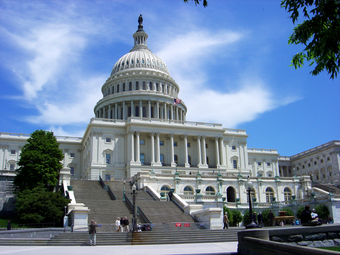
The United State Capitol Building
The United States congress meets in the Capitol.
15.4.6: The Political Participation of Women
Women’s political participation has increased due to landmark events—women’s suffrage and the election of women to public office.
Learning Objective
Break down the achievements and shortcomings of the battle for women’s rights in the U.S.
Key Points
- Women’s rights are entitlements and freedoms claimed for women and girls of all ages in many societies.
- In some places these rights are institutionalized or supported by law, local custom, and behavior, whereas in others they may be ignored or suppressed.
- Woman suffrage in the United States was achieved gradually, at state and local levels, during the 19th century and early 20th century, culminating in 1920 with the passage of the Nineteenth Amendment to the United States Constitution.
- The Nineteenth Amendment of the U.S. Constitution states that “The right of citizens of the United States to vote shall not be denied or abridged by the United States or by any State on account of sex”.
- The Equal Rights Amendment was a proposed measure that stated that “equality of rights under the law shall not be denied or abridged by the United States or any state on account of sex.” The amendment died in 1982 because not enough states had ratified it.
- While women are generally as likely to vote as men in developed countries, women are underrepresented in political positions. Women make up a very small percentage of elected officials, both at local and national levels.
Key Terms
- Equal Rights Amendment
-
The Equal Rights Amendment (ERA) was a proposed amendment to the United States Constitution designed to guarantee equal rights for women.
- Nineteenth Amendment
-
The amendment to the United States Constitution, passed in 1920, that gave women the right to vote.
- suffrage
-
The right or chance to vote, express an opinion or participate in a decision.
Examples
- Women make up a very small percentage of elected officials, both at local and national levels. In the U.S., for instance, in the 109th Congress (2005-2007) there were only 14 female Senators (out of 100) and 70 Congressional Representatives (out of 435).
- Women make up a very small percentage of elected officials, both at local and national levels. In the U.S., for instance, in the 109th Congress (2005-2007) there were only 14 female Senators (out of 100) and 70 Congressional Representatives (out of 435).
Women’s rights are entitlements and freedoms claimed for women and girls of all ages in many societies. In some places these rights are institutionalized or supported by law, local custom, and behavior, whereas in others they may be ignored or suppressed. The women’s rights movement functions in response to an inherent historical and traditional bias against the exercise of rights by women and girls in favor of men and boys.
Women’s suffrage in the United States was achieved gradually, at state and local levels, during the 19th century and early 20th century, culminating in 1920 with the passage of the Nineteenth Amendment to the United States Constitution. The amendment stated, “the right of citizens of the United States to vote shall not be denied or abridged by the United States or by any State on account of sex.” Politicians responded to the newly enlarged electorate by emphasizing issues of special interest to women—prohibition, child health, public schools, and world peace. Women responded to these issues, but in terms of general voting, they shared the same outlook and the same voting behavior as men.
In the United States, the National Organization for Women (NOW) was created in 1966 with the purpose of bringing about equality for all women. NOW was one important group that fought for the Equal Rights Amendment (ERA). This amendment stated that “equality of rights under the law shall not be denied or abridged by the United States or any state on account of sex.” But there was disagreement on how the proposed amendment would be understood. Supporters believed it would guarantee women equal treatment. But critics feared it might deny women the right be financially supported by their husbands. The amendment died in 1982 because not enough states had ratified it. ERAs have been introduced in subsequent sessions of Congress, but they have never been ratified.
While women are generally as likely to vote in developed countries, they are underrepresented in political positions. Women make up a very small percentage of elected officials, both at local and national levels. In the U.S., for instance, in the 109th Congress (2005-2007) there were only 14 female Senators (out of 100) and 70 Congressional Representatives (out of 435).
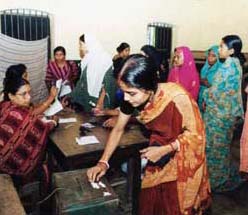
Voting Women
Women standing in line to vote in Bangladesh.
15.4.7: Theories of Democracy
Theories of democracy advocate different degrees of participation by the people with the government.
Learning Objective
Distinguish between parliamentary democracy, minimal democracy, direct democracy, radical democracy and deliberative democracy, and relate them to the concept of “true” democracy and freedom
Key Points
- Democracy, or “rule by the people,” is an egalitarian form of government in which all the citizens of a nation determine public policy, the laws, and the actions of their state together, requiring that all citizens have an equal opportunity to express their opinion.
- The most common system that is deemed “democratic” in the modern world is parliamentary democracy, in which the voting public takes part in elections and chooses politicians to represent them in a legislative assembly.
- Theoretically, Aristotle contrasted rule by the many (democracy/polity) with rule by the few (oligarchy/aristocracy) and with rule by a single person (tyranny or today autocracy/monarchy).
- Under minimalism, democracy is a system of government in which citizens give teams of political leaders the right to rule in periodic elections.
- Direct democracy holds that citizens should participate directly in making laws and policies, and not do so through their representatives.
- Deliberative democracy is based on the notion that democracy is government by discussion.
- Deliberative democracy is based on the notion that democracy is government by discussion.
- Radical democracy is based on the idea that there are hierarchical and oppressive power relations that exist in society
Key Terms
- direct democracy
-
Direct democracy (or pure democracy) is a form of government in which people vote on policy initiatives directly, as opposed to a representative democracy in which people vote for representatives who then vote on policy initiatives.
- deliberative democracy
-
Deliberative democracy or discursive democracy is a form of democracy in which deliberation is central to decision making. Deliberative democracy differs from traditional democratic theory in that authentic deliberation, not mere voting, is the primary source of legitimacy for the lawmaking processes.
- autocracy
-
A form of government in which unlimited power is held by a single individual.
- democracy
-
a system of rule by the people, especially as a form of government; either directly or through elected representatives
What Is A Democracy?
Democracy, or rule by the people, is an egalitarian form of government in which all the citizens of a nation determine public policy, the laws, and the actions of their state together. Democracy requires that all citizens have an equal opportunity to express their opinion. In practice, democracy is the extent to which a given system approximates this ideal, and a given political system is referred to as a democracy if it allows a certain approximation to ideal democracy. Although no country has ever granted all its citizens the right to vote, most countries today hold regular elections based on egalitarian principles, at least in theory.
The most common system that is deemed democratic in the modern world is parliamentary democracy, in which the voting public takes part in elections and chooses politicians to represent them in a legislative assembly. The members of the assembly then make decisions with a majority vote. A purer form is direct democracy in which the voting public makes direct decisions or participates directly in the political process. Elements of direct democracy exist on a local level and, in exceptions, on the national level in many countries, though these systems coexist with representative assemblies.
Theoretically, Aristotle contrasted rule by the many (democracy/polity) with rule by the few (oligarchy/aristocracy) and with rule by a single person (tyranny or autocracy/monarchy). He also thought that there was a good and a bad variant of each system (he considered democracy to be the degenerate counterpart to polity). For Aristotle, the underlying principle of democracy is freedom, since only in a democracy can the citizens have a share in freedom. There are two main aspects of freedom: (1) being ruled and ruling in turn, since everyone is equal according to number, not merit, and; (2) to be able to live as one pleases.
Among political theorists, there are many contending conceptions of democracy:
Minimalist Democracy
Under minimalism, democracy is a system of government in which citizens give teams of political leaders the right to rule in periodic elections. According to this minimalist conception, citizens cannot and should not rule because, for example, on most issues, most of the time, they have no clear views or their views are not well-founded.
Direct Democracy
Direct democracy, on the other hand, holds that citizens should participate directly in making laws and policies, and not do so through their representatives. Proponents of direct democracy offer varied reasons to support this view, declaring that political activity can be valuable in itself, since it socializes and educates citizens, and popular participation can check powerful elites. Most importantly, according to this theory, citizens do not really rule themselves unless they directly decide laws and policies for themselves.
Deliberative Democracy
Deliberative democracy is based on the notion that democracy is government by discussion. Deliberative democrats contend that laws and policies should be based upon reasons that all citizens can accept. The political arena should be one in which leaders and citizens make arguments, listen, and change their minds.
Radical Democracy
Radical democracy is based on the idea that there are hierarchical and oppressive power relations that exist in society. Democracy’s role is to make visible and challenge those relations by allowing for difference, dissent, and antagonisms in the decision making processes.
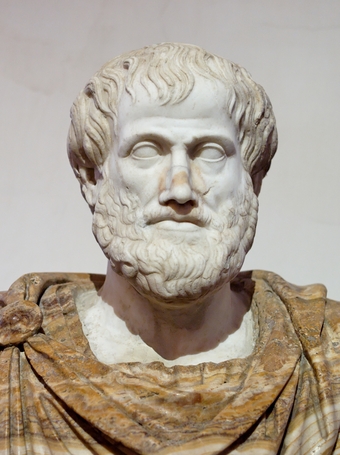
Aristotle
Aristotle was one of the first theorists of democracy.
15.4.8: Public Sphere and Civil Society
The public sphere is composed of voluntary associations that promote social capital and social cohesion while enhancing democracy.
Learning Objective
Formulate an argument which advocates for a strong civil society based on the definitions of civil society in this text
Key Points
- Civil society is the arena outside of the family, the state, and the market where people associate to advance common interests.
- Voluntary associations build social capital, trust, and shared values, which are transferred into the political sphere and help to hold society together, facilitating an understanding of the interconnectedness of society and interests within it.
- Critics argue that the public sphere can be undemocratic, noting that civil society actors have now obtained a remarkable amount of political power without anyone directly electing or appointing them.
- The public sphere is an area in social life where individuals can come together to freely discuss and identify societal problems, and through that discussion influence political action.
- The basic belief in public sphere theory is that political action is steered by the public sphere and that the only legitimate governments are those that listen to the public sphere.
- The basic belief in public sphere theory is that political action is steered by the public sphere and that the only legitimate governments are those that listen to the public sphere.
Key Terms
- Third sector
-
The voluntary sector or community sector (also non-profit sector or “not-for-profit” sector) is the sphere of social activity undertaken by organizations that are for non-profit and non-governmental. This sector is also called the third sector, in reference to the public sector and the private sector. Civic sector is another term for the sector, emphasizing the sector’s relationship to civil society.
- Public sphere
-
The public sphere is an area in social life where individuals can come together to freely discuss and identify societal problems, and through that discussion influence political action. It mediates between the private sphere and the Sphere of Public Authority.
- Sphere of Public Authority
-
The Sphere of Public Authority is that of the state, the realm of the police, and the ruling class.
Example
- In his book Bowling Alone, Robert Putnam gave the famous example of bowling leagues as a voluntary association that makes up civil society. Years ago, people used to come together in bowling leagues to bowl with their friends and compete against other leagues. These leagues brought people together outside of work and family obligations, giving them a third space for association. But over the years, bowling leagues have become less common (and, according to Putnam, so have all types of voluntary associations). Because of this, people have fewer ties to other people outside of work or home. That has decreased opportunities to engage with others, build social capital, trust, shared values, and so on. According to Putnam, this has had a deleterious effect on democracy.
Civil society is the arena outside of the family, the state, and the market where people associate to advance common interests. It is sometimes considered to include the family and the private sphere and then referred to as the third sector of society, distinct from government and business. Dictionary.com’s 21st Century Lexicon defines civil society as 1) the aggregate of non-governmental organizations and institutions that manifest interests and will of citizens, or 2) individuals and organizations in a society which are independent of the government. Sometimes the term is used in the more general sense of “the elements such as freedom of speech, an independent judiciary, etc, that make up a democratic society. “
Civil Society and Democratic Political Society
The literature on relations between civil society and democratic political society have their roots in early liberal writings like those of Alexis de Tocqueville. However, they were developed in significant ways by 20th century theorists like Gabriel Almond and Sidney Verba, who identified the role of political culture in a democratic order as vital. They argued that the political element of many voluntary organizations facilitates better awareness and a more informed citizenry, who make better voting choices, participate in politics, and hold government more accountable as a result. The statutes of these organizations have often been considered micro-constitutions because they accustom participants to the formalities of democratic decision making.
More recently, Robert D. Putnam has argued that even non-political organizations in civil society are vital for democracy. This is because they build social capital, trust, and shared values, which are transferred into the political sphere and help to hold society together, facilitating an understanding of the interconnectedness of society, and interests within it.
Others, however, have questioned how democratic civil society actually is. Some have noted that the civil society actors have now obtained a remarkable amount of political power without anyone directly electing or appointing them. It has also been argued that civil society is biased towards the global north. Partha Chatterjee has argued that, in most of the world, “civil society is demographically limited. ” For Jai Sen, civil society is a neo-colonial project driven by global elites in their own interests. Finally, other scholars have argued that, since the concept of civil society is closely related to democracy and representation, it should in turn be linked with ideas of nationality and nationalism.
The Public Sphere
The public sphere is an area in social life where individuals can come together to freely discuss and identify societal problems, and through that discussion influence political action. It is “a discursive space in which individuals and groups congregate to discuss matters of mutual interest and, where possible, to reach a common judgment. ” The public sphere can be seen as “a theater in modern societies in which political participation is enacted through the medium of talk” and “a realm of social life in which public opinion can be formed. “
The public sphere mediates between the private sphere and the Sphere of Public Authority, “The private sphere comprised civil society in the narrower sense, that is to say, the realm of commodity exchange and of social labor. ” Whereas the Sphere of Public Authority dealt with the state, or realm of the police and the ruling class, the public sphere crossed over both these realms and “through the vehicle of public opinion it put the state in touch with the needs of society. ” “This area is conceptually distinct from the state: it [is] a site for the production and circulation of discourses that can in principle be critical of the state. ” The public sphere “is also distinct from the official economy; it is not an arena of market relations but rather one of discursive relations, a theater for debating and deliberating rather than for buying and selling. ” These distinctions between “state apparatuses, economic markets, and democratic associations…are essential to democratic theory. ” The people themselves came to see the public sphere as a regulatory institution against the authority of the state. The study of the public sphere centers on the idea of participatory democracy, and how public opinion becomes political action.
The basic belief in public sphere theory is that political action is steered by the public sphere and that the only legitimate governments are those that listen to the public sphere. “Democratic governance rests on the capacity of and opportunity for citizens to engage in enlightened debate. ” Much of the debate over the public sphere involves what is the basic theoretical structure of the public sphere, how information is deliberated in the public sphere, and what influence the public sphere has over society.

Elks Lodge in Ashland, Wisconsin
Voluntary associations, such as Elks Clubs, make up the public sphere.
15.5: The U.S. Political System
15.5.1: The U.S. Political System
The United States is a representative federal democracy driven by elections in which citizens’ and lobbyists’ diverse interests compete.
Learning Objective
List three defining characteristics of the U.S. political system
Key Points
- U.S. politics are shaped by two major political parties: Democrats and Republicans.
- Citizens have competing interests that differ based on their different backgrounds—the types of jobs they have, their race or age, whether they have children, etc.
- Politics are also shaped by special interest groups, lobbyists, and the media.
Key Term
- lobbyist
-
A person remunerated to persuade (to lobby) politicians to vote in a certain way or otherwise use their office to affect a desired result.
The U.S. federal government is composed of three distinct branches—legislative, executive, and judicial—whose powers are vested by the U.S. Constitution in the Congress, the President, and the federal courts, including the Supreme Court, respectively .
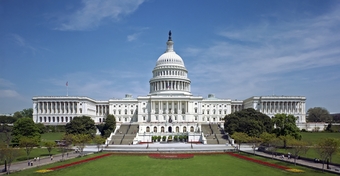
Congress
The legislative branch of the U.S. government.
The United States is a representative democracy. Citizens elect representatives to national, state, and local government; those representatives create the laws that govern U.S. society. Although nothing in U.S. law requires it, in practice, the political system is dominated by political parties. With rare exceptions, elections are decided between the two major parties: Democrats and Republicans. Although citizens vote for individual candidates, most candidates are affiliated with one part or another. Therefore, much of U.S. politics boils down to party politics.
The United States is also a diverse society, and citizens’ competing interests are reflected in politics. Citizens may have different voting preferences depending on their family backgrounds, the types of jobs they have, their race or age, whether they have children, and so on. To understand the electoral process, we must understand how different interests come into play.
Individual citizens are not the only players in U.S. politics. Although individual citizens are the only ones who can cast votes, special interest groups and lobbyists may influence elections and law-making with money and other resources. At times, this influence has grown so noticeable that some have called into question whether the U.S. is truly a democracy of the people or something more like an oligarchy of special interest groups. The media also play an important role in politics by influencing public sentiment and acting as an information filter.
15.5.2: Political Parties and Elections
Political parties seek to influence government policy by nominating select candidates to hold seats in political offices.
Learning Objective
Evaluate the party system, both in proportional representation voting systems and two-party systems
Key Points
- Parties participate in electoral campaigns and educational outreach or protest actions.
- Parties often espouse an expressed ideology or vision bolstered by a written platform with specific goals, forming a coalition among disparate interests.
- The type of electoral system is a major factor in determining the type of political party system.
- In countries that have a proportional representation voting system, three or more parties are often elected to parliament in significant proportions, and thus may have more access to public office.
- In two-party systems, two political parties dominate to such an extent that electoral success under the banner of any other party is almost impossible.
- Political parties, still called factions by some, are lobbied vigorously by organizations, businesses, and special interest groups such as trades unions.
- Multi-party systems are systems in which more than two parties are represented and elected to public office.
- Political parties, still called factions by some, are lobbied vigorously by organizations, businesses, and special interest groups such as trades unions.
Key Terms
- proportional representation
-
A voting principle aimed at securing a close match between the percentage of votes that groups of candidates (usually political parties) obtain in elections, and the percentage of seats they receive in the elected body.
- two-party system
-
A two-party system is a system where two major political parties dominate voting in nearly all elections at every level of government and, as a result, all or nearly all elected offices are members of one of the two major parties.
- faction
-
A group of people, especially within a political organization, who express a shared belief or opinion different from people who are not part of the group.
Typically, a political party is a political organization seeking to influence government policy by nominating its own select candidates to hold seats in political office, via the process of electoral campaigning. Parties often espouse an expressed ideology or vision, bolstered by a written platform with specific goals that form a coalition among disparate interests.
The type of electoral system is a major factor in determining the type of party political system. In countries with a simple plurality voting system there can be as few as two parties elected in any given jurisdiction. In countries that have a proportional representation voting system, as exists throughout Europe, or a preferential voting system, such as in Australia or Ireland, three or more parties are often elected to parliament in significant proportions, allowing more access to public office. In a nonpartisan system, no official political parties exist, sometimes due to legal restrictions on political parties. In nonpartisan elections, each candidate is eligible for office on his or her own merits. In nonpartisan legislatures, no formal party alignments within the legislature is common.
In two-party systems, such as in Jamaica and Ghana, the two political parties dominate to such an extent that electoral success under the banner of any other party is virtually impossible. Multi-party systems are systems in which more than two parties are represented and elected to public office. Australia, Canada, Pakistan, India, Ireland, the United Kingdom, and Norway are examples of countries with two strong main parties, along with smaller or “third” parties that have also obtained representation. The smaller parties may form part of a coalition government together with one of the larger parties, or act independently.
Political parties, still called factions by some, are lobbied vigorously by organizations, businesses and special interest groups such as trades unions. Money and gifts-in-kind to a party, or its leading members, may be offered as incentives. Such donations are the traditional source of funding for all right-of-center cadre parties. In the late 19th century, these parties faced opposition by the newly founded left-of-center workers’ parties, who formed a new party type—the mass membership party—and a new source of political fundraising—membership dues.

Republican Party, 1985
Ronald Reagan giving his Acceptance Speech at the Republican National Convention, Detroit, MI.
15.5.3: Voting Behavior
Voter turnout depends on socioeconomic factors such as education, income, gender, age, and race.
Learning Objective
Describe a few factors that determine voter turnout
Key Points
- Voter turnout is the percentage of eligible voters who cast a ballot in an election. “Eligible voters” are defined differently in different countries, and the term should not be confused with the total adult population.
- Socioeconomic factors significantly affect how likely individuals are to vote. The most important socioeconomic factor in voter turnout is education. The more educated a person is, the more likely he or she is to vote.
- While women are generally as likely to vote as men in developed countries, women are underrepresented in political positions.
- Age is another crucial factor determining voter turnout. Young people are much less likely to vote than are older people, and they are less likely to be politicians.
- Generally, racial and ethnic minorities are less likely to vote in elections and are underrepresented in political positions.
- Political power is also stratified through income and education. Wealthier and more educated people are more likely to vote.
Key Terms
- voter turnout
-
Voter turnout is the percentage of eligible voters who cast a ballot in an election.
- socioeconomic factors
-
Socioeconomic factors include education, income, ethnicity, race, and gender.
- racial and ethnic minorities
-
A group of people who have a different ethnicity, religion, language, or culture than that of the majority of people in the place where they live.
Voter Turnout
Voter turnout is the percentage of eligible voters who cast a ballot in an election. “Eligible voters” are defined differently in different countries, and the term should not be confused with the total adult population. After increasing for many decades, there has been a trend of decreasing voter turnout in most established democracies since the 1960s . In general, low turnout may be due to disenchantment, indifference, or contentment. Low turnout is often considered to be undesirable, and there is much debate over the factors that affect turnout and how to increase it. In spite of significant study devoted to the issue, scholars are divided on reasons for the decline. The causes of decreasing turnout have been attributed to a wide array of economic, demographic, cultural, technological, and institutional factors. There have been many efforts to increase turnout and encourage voting.
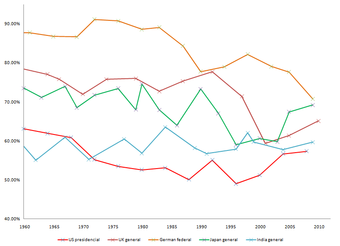
Voter turnout over time for five countries
Change in voter turnout over time for five selected countries.
In each nation, some parts of society are more likely to vote than others. In high-turnout nations, these differences tend to be limited: as turnout approaches 90 percent, it becomes difficult to find differences of much significance between voters and nonvoters. In low turnout nations, however, the differences between voters and non-voters can be quite marked. Socioeconomic factors significantly affect whether or not individuals voting tendencies. The most important socioeconomic factor in voter turnout is education. The more educated a person is, the more likely he or she is to vote, even when controlling for other factors such as income and class that are closely associated with education level .
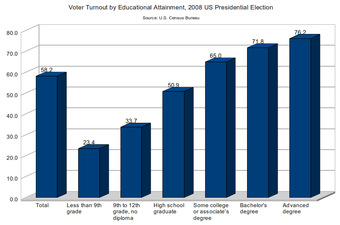
Voter Turnout by Educational Attainment –2008 Presidential Election
Educational attainment, an indicator of social class, can predict one’s level of political participation. Those with high educational attainment are more likely to vote in elections than those with little education.
Gender, Age, Ethnicity, Race, Income
There is some debate over the effects of ethnicity, race, and gender on voter turnout. While women are generally as likely as men to vote in developed countries, women are underrepresented in political positions. Women make up a very small percentage of elected officials, both at local and national levels. In the U.S., for instance, in the 109th Congress (2005-2007) there were only 14 female Senators (out of 100) and 70 Congressional Representatives (out of 435).
Age is another crucial factor determining voter turnout. Young people are much less likely to vote than are older people, and they are less likely to be politicians. The lower voting rates of young people in the U.S. help explain why things like Medicare and Social Security in the U.S. are facing looming crises: the elderly will retain many of the benefits of these programs and are unwilling to allow them to be changed even though young people will be the ones to suffer the consequences of these crises.
Generally, racial and ethnic minorities are less likely to vote in elections and are also underrepresented in political positions. If blacks were represented in proportion to their numbers in the U.S., there should be 12 Senators and 52 Members of the House. In 2009, there was 1 black Senator (Roland Burris) and 39 Members of the House. In 2010, the number in the House increased slightly to 41 (7.8 percent), but remained at just 1 percent of the Senate.
Political power is also stratified through income and education. Wealthier and more educated people are more likely to vote. Additionally, wealthier and more educated people are more likely to hold political positions. In the 2004 U.S. Presidential Election, the candidates, John Kerry, and George W. Bush, were both Yale University alumni. John Kerry was a lawyer and George W. Bush had an MBA from Harvard. Both were white, worth millions of dollars, and came from families involved in politics.
15.5.4: Lobbyists and Special Interest Groups
Lobbying describes paid activity in which special interest groups argue for specific legislation in decision-making bodies.
Learning Objective
Analyze the significance of lobbying according to its multiple instantiations
Key Points
- Lobbying in the United States describes paid activity in which special interests hire well-connected, professional advocates, often lawyers.
- Lobbying happens at every level of government, including federal, state, county, municipal, and local governments.
- A lobbyist, according to the legal sense of the word, is a professional, often a lawyer.
- Pro bono clients offer activities like fundraisers and awards ceremonies on neutral territory to meet and socialize with local legislators.
- Corporations which lobby actively tend to be few in number, large, and often sell to the government.
Key Terms
- corporations
-
Plural of corporation.
- lobbyist
-
A person remunerated to persuade (to lobby) politicians to vote in a certain way or otherwise use their office to effect a desired result.
Example
- When people think about lobbying, they often imagine corruption and poor policy results. Lobbying does not always have such deleterious effects. But sometimes it does. According to critics, lobbying can lead to poor policymaking because legislators do not consider policies based on their merits but instead based on their political repercussions. For example, food industry lobbyists and healthcare lobbyists recently clashed over the issue of school lunches. A group supported by the United States Department of Agriculture proposed healthier lunches as a way to combat childhood obesity by limiting the number of potatoes served, limiting salty foods, and adding more fresh vegetables. This group was countered by a strong food lobby backed by Coca-Cola, Del Monte, and makers of frozen pizza. The food lobbyists succeeded in blocking the proposed reforms, even writing rules suggesting that the tomato paste on a pizza qualified as a vegetable. According to critics, this case appeared to be an example where business interests won out over health concerns.
Lobbying in the United States describes paid activity in which special interests hire well-connected professional advocates, often lawyers, to argue for specific legislation in decision-making bodies such as the United States Congress. It is a highly controversial phenomenon, often seen in a negative light by journalists and the American public, and frequently misunderstood. The current pattern suggests much lobbying is done by corporations although a wide variety of coalitions representing diverse groups are possible. Lobbying happens at every level of government, including federal, state, county, municipal, and even local governments.
Lobbyists are intermediaries between client organizations and lawmakers: They explain to legislators what their organizations want, and they explain to their clients what obstacles elected officials face. Many lobbyists work in lobbying firms or law firms, some of which retain clients outside of lobbying. Others work for advocacy groups, trade associations, companies, and state and local governments. Lobbyists can also be one type of government official, such as a governor of a state, who presses officials in Washington for specific legislation.
While the bulk of lobbying happens by business and professional interests who hire paid professionals, some lobbyists represent non-profits and work pro bono for issues in which they are personally interested. Pro bono clients offer activities like fundraisers and awards ceremonies on neutral territory to meet and socialize with local legislators.
Corporations which lobby actively tend to be large corporations, few in number, and often they sell to the government. Most corporations do not hire lobbyists. One study found that the actual number of firms which do lobbying regularly is fewer than 300, and that the percent of firms engaged in lobbying was 10 percent from 1998-2006. Corporations considering lobbying run into substantial barriers to entry: Corporations have to research the relevant laws about lobbying, hire lobbying firms, and cultivate influential people and make connections. For example, when an issue regarding a change in immigration policy arose, large corporations that were currently lobbying switched focus somewhat to take account of the new regulatory world, but new corporations—even ones likely to be affected by any possible rulings on immigration—stayed out of the lobbying fray, according to the study.

The Defense Lobby
Defense contractors such as Boeing and Lockheed Martin sell extensively to the government and must, of necessity, engage in lobbying to win contracts.
15.5.5: African Americans as a Political Force
Collectively, African Americans are more involved in the American political process than other minority groups.
Learning Objective
Sketch an outline of the general African-American influence on U.S. politics from the mid 1800s to today
Key Points
- African Americans have the highest level of Congressional representation of any minority group in the U.S., though this doesn’t extend to the senate.
- Historically, African Americans were supporters of the Republican Party because it was Republican President Abraham Lincoln who granted freedom to American slaves.
- The African American trend of voting for Democrats can be traced back to the 1930s during the Great Depression, when Franklin D. Roosevelt’s New Deal program provided economic relief for African Americans.
- African Americans tend to be conservative on issues related to the family but progressive on questions of social justice and social spending. They tend to hold far more conservative opinions on abortion, extramarital sex, and raising children out of wedlock than Democrats as a whole.
Key Terms
- Republican Party
-
The Republican Party is one of the two major political parties in the United States, along with the Democratic Party. Founded by anti-slavery activists in 1854, it dominated politics nationally for most of the period 1860-1932. Currently the party’s platform generally reflects American conservatism in the U.S. political spectrum.
- Great Depression
-
A major economic collapse that lasted from 1929 to 1940 in the US and a similar period in many other countries.
- conservative
-
A person who favors maintenance of the status quo or reversion to some earlier status.
Collectively, African Americans are more involved in the American political process than other minority groups, indicated by the highest level of voter registration and participation in elections among these groups in 2004 . African Americans collectively attain higher levels of education than immigrants to the United States. African Americans also have the highest level of Congressional representation of any minority group in the U.S, though this doesn’t extend to the senate .
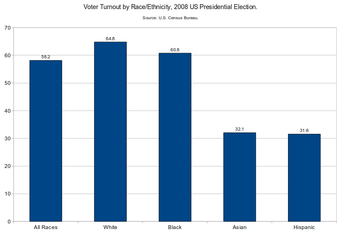
Voter Turnout by Race, 2008 Presidential Election
This is a chart illustrating voter turnout by race for the 2008 Presidential Election using data from the U.S. Census Bureau.

Senator Roland Burris
Although African Americans have high political participation rates, they are underrepresented in political office. Senator Roland Burris, of Illinois, is currently the only African American senator.
The large majority of African Americans support the Democratic Party. In the 2004 Presidential Election, Democrat John Kerry received 88 percent of the African American vote, compared to 11 percent for Republican George W. Bush. Although there is an African American lobby in foreign policy, it has not had the impact that African American organizations have had in domestic policy.
Historically, African Americans were supporters of the Republican Party because it was Republican President Abraham Lincoln who granted freedom to American slaves; at the time, the Republicans and Democrats represented the sectional interests of the North and South, respectively, rather than any specific ideology—both right and left were represented equally in both parties.
The African American trend of voting for Democrats can be traced back to the 1930s during the Great Depression, when Franklin D. Roosevelt’s New Deal program provided economic relief for African Americans. Roosevelt’s New Deal coalition turned the Democratic Party into an organization of the working class and their liberal allies, regardless of region. The African American vote became even more solidly Democratic when Democratic presidents John F. Kennedy and Lyndon B. Johnson pushed for civil rights legislation during the 1960s.
African Americans tend to hold far more conservative opinions on abortion, extramarital sex, and raising children out of wedlock than Democrats as a whole. On financial issues, they are in line with Democrats, generally supporting a more progressive tax structure to provide more services and reduce injustice and as well as more government spending on social services.
15.5.6: Hispanics as a Political Force
Hispanics have the ability to be an influential force in politics, a fact that is especially true in areas with high Hispanic populations.
Learning Objective
Explain the nuances within the so-called ”Hispanic vote”
Key Points
- The term Hispanic is used in the United States to refer to people with origins in Spanish-speaking countries, like Mexico, Cuba, Puerto Rico, and Costa Rica.
- The majority of Hispanics either identify themselves as Democrats or support the Democratic party.
- Due to the homogeneity among Hispanic voters, they have the ability to be an influential force in American politics. This is especially true in areas with high Hispanic populations, and, based on demographic predictions, will continue to be important throughout the 21st century.
- Depending on their ethnicity and background, Hispanics differ on voting trends. For example, Cuban Americans and Colombian Americans tend to favor conservative political ideologies. In contrast, Mexican Americans, Puerto Rican Americans, and Dominican Americans tend to favor liberal views.
- The Presidency of George W. Bush had a significant impact on the political leanings of Hispanics and Latinos.
- In the 2006 midterm election, however, due to the unpopularity of the Iraq War, the heated debate concerning illegal immigration, and Republican-related Congressional scandals, Hispanics and Latinos went as strongly Democratic as they have since the Clinton years.
Key Terms
- Hispanic
-
of or relating to a Spanish-speaking people or culture, as in Latin America.
- midterm election
-
an election, held every four years, to elect members of Congress; during midterm elections, the president is not elected
- Democratic Party
-
The Democratic Party is one of two major contemporary political parties in the United States, the other of which is the Republican Party.
Example
- Some political organizations associated with Hispanic and Latino Americans are LULAC, the NCLR, the United Farm Workers, the Cuban American National Foundation, and the National Institute for Latino Policy
The term Hispanic, as defined by the Office of Management and Budget, is used in the United States to identify people with origins in Spanish-speaking countries, like Mexico, Peru, Cuba, or Costa Rica.
Hispanic Party Affiliation
Depending on their location and background, Hispanics differ on their political views. While Hispanics have a diversity of views, they disproportionately identify themselves as Democratic and/or support Democratic candidates. Only 23% of Hispanics identify as Republicans. For example, in the 2010 midterm elections, in spite of general Republican victories, 60% of Hispanics voted Democratic, while only 38% voted Republican. In 2008, 67% of Hispanics supported Obama. In 2006, 69% of Hispanic voters supported Democratic candidates in congressional races, while only 30% supported Republican candidates.
Demographic Trends
Due to the homogeneity among Hispanic voters, they have the ability to be an influential force in American politics. This is especially true in areas with high Hispanic populations. Statistics indicate that the American Hispanic population is increasing and will continue to do so steadily over the ensuing decades of the 21st century . A 2012 study, conducted by the Center for Immigration Studies, projected that in November 2012, Hispanics would comprise 17.2% of the total U.S. population. The same study showed that, in the United States, Hispanics now constitute 15% of adults, 11.2% of adult citizens, and 8.9% of actual voters. In comparison, the same study showed that in 2012, non-Hispanic whites were expected to constitute 73.4% of the national vote. Non-Hispanic blacks were only expected to represent 12.2% of the national vote.
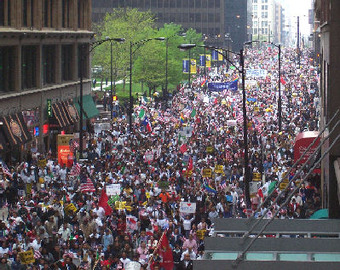
An Immigration Rally in Chicago, 2006
Immigration is an important issue for may Hispanic and Latino voters.
Political Differences in the Hispanic Community
Hispanics are often classified as a unitary voting bloc, but there are differences in political preferences within this community. For example, Cuban Americans and Colombian Americans tend to favor conservative political ideologies and to support the Republican Party. Mexican Americans, Puerto Rican Americans, and Dominican Americans, on the other hand, tend to favor liberal views and to support the Democratic party. That being said, because the latter groups are far more numerous (Mexican Americans account for 64% of Hispanics in the U.S.) the Democratic Party is considered to be in a far stronger position with Hispanics overall.
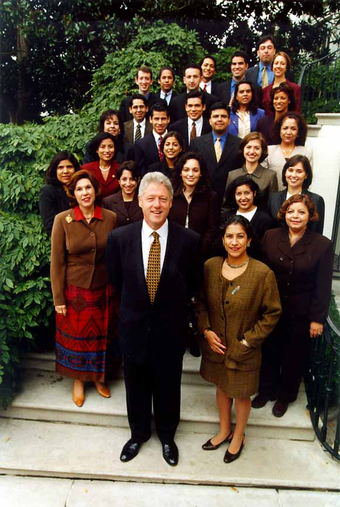
President Clinton’s Latino Appointees, 1998
Hispanics and Latinos made political gains under the Clinton Administration. This 1998 photograph shows President Bill Clinton and his Hispanic and Latino appointees.
15.5.7: The Role of the Media
Media are means of transmitting information, which is important for a democracy in which citizens must make their own informed decisions.
Learning Objective
Give a concrete example of gatekeeping that may have political consequences
Key Points
- In communications, media are the storage and transmission channels or tools used to store and deliver information or data.
- Media of the United States consist of several different types of communications media: television, radio, cinema, newspapers, magazines, and Internet-based Web sites.
- Ninety-nine percent of American households have at least one television, and the majority of households have more than one.
- A central method in which the media influences the U.S. political system is through gatekeeping, a process through which information is filtered for dissemination, be it publication, broadcasting, the Internet, or some other type of communication.
- The Internet has provided a means for newspapers and other media organizations to deliver news and, significantly, the means to look up old news. Some organizations only make limited amounts of their output available for free and charge for access to the rest.
- The U.S. has three leading weekly newsmagazines: Time, Newsweek, and U.S. News and World Report.
- The Internet has provided a means for newspapers and other media organizations to deliver news and, significantly, the means to look up old news. Some organizations only make limited amounts of their output available for free and charge for access to the rest.
Key Terms
- Gatekeeping
-
Gatekeeping is practiced by gatekeepers, people who control access to something, for example, via a city gate. In the late twentieth century, the term came into metaphorical use, referring to individuals who decide whether a given message will be distributed by a mass medium.
- media
-
In communications, media (singular medium) are the storage and transmission channels or tools used to store and deliver information or data.
Example
- Media can influence politics by what they say, but also by what they don’t say. Gatekeeping is the process through which information is filtered for dissemination, be it publication, broadcasting, the Internet, or some other type of communication. Gatekeeping occurs at all levels of the media structure, from a reporter deciding which sources are included in a story to editors deciding which stories are printed or covered, and includes media outlet owners and even advertisers. In 1950, the idea of gatekeeping was officially applied to news. David Manning White looked at the factors an editor takes into consideration when deciding which news will make the paper and which news will not. White contacted an editor, a man called Mr. Gates who was in his mid-40s and had 25 years of experience in journalism. Mr. Gates was the wire editor of a morning newspaper with a circulation of 30,000 in a mid-west city of 100,000. As it happened, he retained all copy (news stories) that he rejected from the paper. After his shift, he made notes on why each story was rejected, assuming he could still remember the reason. White wanted to know whether Mr. Gates’s decisions were objective or whether they were subjective and based on the editor’s own set of experiences, attitudes, and expectations. He found that rejections could be classified in two ways: 1) rejecting based on not being worthy of being reported or 2) rejecting based on duplicate of other reports on the same thing. These considerations fit with what we call news norms today: objective decisions about what is fit to print. However, Mr. Gates also admitted to preferring political news to other types, trying to avoid sensationalism, not liking suicide stories, and preferring stories that were more narrative and did not contain facts or figures. He also admitted that he did not like giving page space to a scandal that had been going on in the Catholic Church at the time. Thus, Mr. Gates was acting as a gatekeeper by making decisions about what sorts of news would receive space in his newspaper.
In communications, media are the storage and transmission channels or tools used to store and deliver information or data. Media are often referred to as synonymous with mass media or news media, but may refer to a single medium used to communicate any data for any purpose. Media of the United States consist of several different types of communications media: television, radio, cinema, newspapers, magazines, and Internet-based Web sites. American media conglomerates tend to be leading global players, generating large revenues, as well as large opposition in many parts of the world.
A central method in which the media influences the U.S. political system is through gatekeeping, a process through which information is filtered for dissemination, be it publication, broadcasting, the Internet, or some other type of communication. Gatekeeping occurs at all levels of the media structure, from a reporter deciding which sources are included in a story to editors deciding which stories are printed or covered, and includes media outlet owners and even advertisers. This, in turn, determines to a great extent which issues will be important to Americans and on the agendas of their elected officials.
The Internet has provided a means for newspapers and other media organizations to deliver news and, significantly, the means to look up old news. Some organizations only make limited amounts of their output available for free, and charge for access to the rest. Other organizations allow their archives to be freely browsed. It is possible that the latter type obtain more influence, as they are true to the spirit of freedom of information by virtue of making it free. Anyone who has followed external links only to be confronted with a pay-to-view banner might attest that the reputations of organizations that charge is not enhanced by their charging policy, particularly when the same information is available from sources that don’t charge.
15.5.8: The Role of Age
There is a correlation between age and political activity/organization.
Learning Objective
Explain the ways in which age can influence political participation
Key Points
- Age influences rates of political participation, and it is a determining factor in the issues people care about.
- Older people tend to be more politically active and better organized. They are seen as being more influential in politics.
- Young people are less likely to vote than older people.
- The 2008 election of President Obama illustrated that young people can be organized and mobilized. Obama’s ability to mobilize young people was seen as a crucial factor in his electoral success.
Key Terms
- AARP
-
AARP, formally the American Association of Retired Persons, is a United States-based non-governmental organization and interest group, founded in 1958 by Ethel Percy Andrus, PhD, a retired educator from California. The organization is based in Washington, D.C. According to its mission statement, it is “a nonprofit, nonpartisan membership organization for people age 50 and over … dedicated to enhancing quality of life for all as we age, [providing] a wide range of unique benefits, special products, and services for our members. “
- new media
-
Interactive digital media, such as the Internet, as opposed to traditional media such as print and television.
Example
- Older people are well organized by advocacy groups such as the AARP, which lobby on their behalf.
Age and Politics
Age is an important factor in U.S. politics because there is a correlation between age and rates of political participation and because it is a determining factor in the issues people care about.
Young people are much less likely to vote than are older people and are less likely to be politicians. The lower voting rates of young people in the U.S. help explain why things like Medicare and Social Security in the U.S. are facing looming crises—the elderly will retain many of the benefits of these programs and are unwilling to allow them to be changed even though young people will be the ones to suffer the consequences of these crises. Older people are also more organized, through organizations like the AARP, and they are more likely to vote as a block on issues that affect them directly. As a result, older individuals in the U.S. are seen as having more political power than younger people.
Mobilization According to Age
Given that there is a correlation between age and the issues relevant to those populations, some organizations have capitalized on these relationships in order to push political agendas.
Mobilizing the Elderly
The AARP, formerly the American Association of Retired Persons, is a United States-based, non-governmental organization and interest group, founded in 1958. Its mission is to improve the quality of life for retired people and people over the age of 50. On the one hand, AARP pursues its mission by providing services such as tax preparation help, discounts, and insurance for its members. On the other hand, AARP pursues its mission by mobilizing its immense resource base to lobby for policy change. AARP claims around 38 million members, making it one of the largest membership organizations in the United States. Its total revenue in 2006 was approximately $1 billion, of which $23 million was spent on lobbying. The AARP lobbies for issues that matter to older adults, such as health care and social security.
Mobilizing the Youth
Although they tend to be less organized and participate in lower numbers, young people also influence U.S. politics. Barack Obama was particularly noted for his popularity among young people. Obama’s campaign used the Internet to rally supporters and make his policies known, and the campaign’s use of the Internet targeted 18- to 29-year-olds, the age group most reliant on new media for political information. Obama’s campaign managers understood younger voters tended to ignore politicians because politicians tended to ignore issues which most concerned them. Politicians such as Obama focus on issues that are relevant to certain age groups in order to mobilize support. Obama’s ability to focus on these issues and reach out to young people is seen as one of the reasons for his success in the 2008 presidential election .
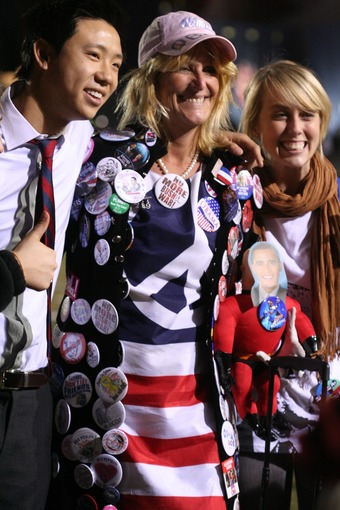
Young Obama Supporters, 2008
Barack Obama’s 2008 Presidential campaign was notable for attracting large numbers of young voters.
15.6: War and Terrorism
15.6.1: War
War is an organized, armed, and often prolonged conflict that is carried on between states, nations, or other parties.
Learning Objective
Recall three possible outcomes of a civil war
Key Points
- War entails confrontation with weapons, military technology, or equipment used by armed forces who employ military tactics and operational art within the broad categories of military strategy and military logistics.
- Warfare refers to the set of techniques used by a group to carry out war.
- Nuclear warfare is warfare in which nuclear weapons are the primary method of coercing the capitulation of the other side, as opposed to the supporting role nuclear weaponry might take in a more conventional war.
- Where evenly matched adversaries decide that the conflict has resulted in a stalemate, they may cease hostilities to avoid further loss of life and property.
- Negotiations between parties involved at the end of a war often result in a treaty.
- Some hostilities, such as insurgency or civil war, may persist for long periods of time with only a low level of military activity.
- Negotiations between parties involved at the end of a war often result in a treaty.
- Some hostilities, such as insurgency or civil war, may persist for long periods of time with only a low level of military activity.
Key Terms
- treaty
-
A binding agreement under international law concluded by subjects of international law, namely states and international organizations.
- civil war
-
A war fought between factions of the inhabitants of a single country, or the citizens of a single republic.
- insurgency
-
rebellion; revolt; the state of being insurgent
Example
- Negotiations between parties involved at the end of a war often result in a treaty, such as the Treaty of Versailles of 1919, which ended the First World War.
War is an organized, armed, and often prolonged conflict that is carried on between states, nations, or other parties typified by extreme aggression, social disruption, and usually high mortality. War should be understood as an actual, intentional, and widespread armed conflict between political communities, and it is defined as a form of political violence.
War entails confrontation with weapons, military technology, or equipment used by armed forces who employ military tactics and operational art within the broad categories of military strategy and military logistics. War studies by military theorists have sought to identify the philosophy of war and to reduce it to a military science. Conventional warfare is an attempt to reduce an opponent’s military capability through open battle. Conventional war is declared between existing states in which nuclear, biological, or chemical weapons are not used, or they only see limited deployment in support of conventional military goals and maneuvers. Nuclear warfare is warfare in which nuclear weapons are the primary method of coercing the capitulation of the other side, as opposed to the supporting role nuclear weaponry might take in a more conventional war.
The political and economic circumstances of peace following a war are highly situational—post-war political and economic realities can not be forecasted. When evenly adversaries decide that a conflict has resulted in a stalemate, they may cease hostilities to avoid further loss of life and property. They may decide to restore the pre-war territorial boundaries, redraw boundaries at the line of military control, or negotiate to keep or exchange captured territory. Negotiations between parties involved at the end of a war often result in treaties, such as the Treaty of Versailles of 1919, which ended the First World War.
Some hostilities, such as insurgency or civil war, may persist for long periods of time with a low level of military activity. In some cases a treaty is never reached, but fighting may trail off and eventually stop after the political demands of the belligerent groups have been reconciled, a political settlement has been negotiated, the combatants are gradually killed or decide the conflict is futile, or the belligerents cease active military engagement but still threaten each other.
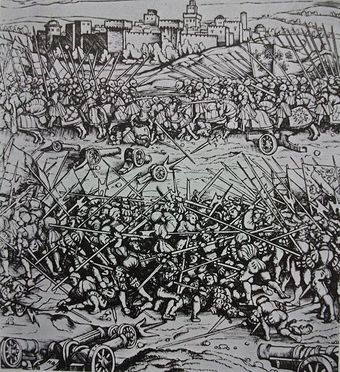
Battle of Ravena (1512)
The Battle of Ravenna, in which France defeated the Spaniards on Easter Sunday in 1512
15.6.2: Terrorism
Terrorism is an act of violence intended to create fear, which is then leveraged in order to achieve goals.
Learning Objective
Criticize an instance in history in which the term ”terrorist” or ”terrorism” has been misused to describe a religious group, government, or revolutionary action, using the definition of terrorism in this text
Key Points
- Terrorism has been practiced by a broad array of political organizations for furthering their objectives.
- An abiding characteristic of terrorism is indiscriminate use of violence against noncombatants to gain publicity for an individual, group or cause.
- The perpetrators of acts of terrorism can be individuals, groups or states.
- Religious terrorism is terrorism performed by groups or individuals, the motivation of which is typically rooted in faith-based tenets.
- The terms “terrorism” and “terrorist” (someone who engages in terrorism) carry strong negative connotations.
Key Terms
- terrorism
-
The deliberate commission of an act of violence to create an emotional response through the suffering of the victims in the furtherance of a political or social agenda.
- perpetrator
-
One who perpetrates; especially, one who commits an offense or crime.
- noncombatant
-
A non-fighting member of the armed forces
Example
- Some terrorist groups may see themselves as first and foremost fighting for liberation, a struggle so important that they argue it justifies unpalatable methods. For example, the ETA (Euskadi Ta Askatasuna) has evolved from a group promoting traditional Basque culture to a paramilitary group with the goal of gaining independence for the Greater Basque Country. ETA is the main organization of the Basque National Liberation Movement and is the most important participant in the Basque conflict. Since 1968, ETA has been held responsible for killing 829 individuals, injuring thousands, and undertaking dozens of kidnappings. The group is proscribed as a terrorist organization by Spanish, British and French authorities, the European Union as a whole, and the United States.
Terrorism is the systematic use of terror, especially as a means of coercion. Although the term lacks a universal definition, common definitions of terrorism refer to violent acts intended to create fear (terror). These acts are perpetrated for a religious, political, or ideological goal, and deliberately target or disregard the safety of non-combatants (civilians).
Terrorism has been practiced by a broad array of political organizations for furthering their objectives. It has been practiced by right-wing and left-wing political parties, nationalistic groups, religious groups, revolutionaries, and ruling governments. An abiding characteristic is the indiscriminate use of violence against noncombatants to gain publicity for a group, cause or individual. Therefore, the power of terrorism comes from its ability to leverage human fear to help achieve these goals.
Terrorists
The terms “terrorism” and “terrorist” carry strong negative connotations. These terms are often used as political labels to condemn such violence as immoral, indiscriminate, or unjustified or to condemn an entire segment of a population. However, some groups, when involved in a liberation struggle, have been called terrorists by the Western governments or media. In some liberation struggles, these same persons can become the leaders or statesman of these liberated nations . Thus, the perpetrators of terrorism can widely vary; terrorists can be individuals, groups or states. According to some definitions, clandestine or semi-clandestine state actors may also carry out terrorist acts outside the framework of a state of war.
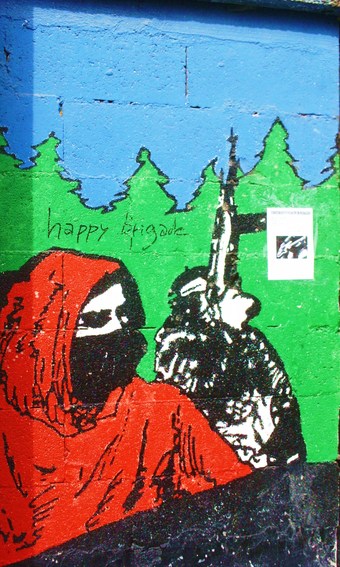
A pro-ETA mural in Durango, Biscay
The ETA is considered a terrorist organization by most governments, but proclaims its own mission to be liberation.
Religious Terrorism
Religious terrorism is performed by groups or individuals, the motivation of which is typically rooted in faith-based tenets. Terrorist acts throughout the centuries have been performed on religious grounds with the hope to either spread or enforce a system of belief, viewpoint or opinion. Religious terrorism does not in itself necessarily define a specific religious standpoint or view, but instead usually defines an individual or group interpretation of that belief system’s teachings.

Terrorist Bomb Attack
A view of damages to the U.S. Embassy in Beirut caused by a terrorist bomb attack, April 1983
15.6.3: Peace
Peace is a state of harmony characterized by the lack of violent conflict or war.
Learning Objective
Explain the difference between principled pacifism and pragmatic pacifism, and what they share in common
Key Points
- Commonly understood as the absence of hostility, peace also suggests the existence of healthy interpersonal or international relationships, prosperity in matters of social or economic welfare, the establishment of equality, and a working political order that serves the true interests of all.
- A peace movement is a social movement seeking to achieve ideals like the ending of a particular war.
- Principled pacifism holds that at some point along the spectrum from war to interpersonal physical violence, such violence becomes morally wrong.
- Pragmatic pacifism holds that the costs of war and inter-personal violence are so substantial that better ways of resolving disputes must be found.
Key Terms
- pragmatic pacifism
-
Pragmatic pacifism holds that the costs of war and interpersonal violence are so substantial that better ways of resolving disputes must be found.
- principled pacifism
-
Principled pacifism holds that at some point along the spectrum from war to interpersonal physical violence, such violence becomes morally wrong.
- international relations
-
International relations (I.R.) is the study of relationships between countries, including the roles of states, inter-governmental organizations (IGOs), international nongovernmental organizations (INGOs), non-governmental organizations (NGOs) and multinational corporations (MNCs).
Example
- The highest honor awarded to a peace maker is the Nobel Prize in Peace, awarded since 1901 by the Norwegian Nobel Committee. It is awarded annually to internationally notable persons following the prize’s creation in the will of Alfred Nobel. Other honorary awards around the world include the Gandhi Peace Prize and the Student Peace Prize.
Peace is a state of harmony characterized by the lack of violent conflict or war. Commonly understood as the absence of hostility, peace also suggests the existence of healthy or newly healed interpersonal or international relationships, prosperity in matters of social or economic welfare, the establishment of equality, and a working political order that serves the true interests of all. In international relations, peacetime is not only the absence of war or conflict, but also the presence of cultural and economic understanding.
Peace Movements
A peace movement is a social movement seeking to achieve ideals like the ending of a particular war (or all wars), while also minimizing inter-human violence with the goal of achieving world peace. Means to achieve these ends usually include advocacy, non-violent resistance, diplomacy, boycotts, moral purchasing, supporting anti-war political candidates, demonstrations, lobbying to create legislation, and pacifism.
Pacifism
Pacifism is the opposition to war or violence as a means of settling disputes or gaining advantage. Pacifism covers a spectrum of views ranging from the belief that international disputes should be peacefully resolved. Other views of pacifism include:
- calls for abolition of the institutions of the military and war
- opposition to any organization of society through governmental force (anarchist or libertarian pacifism)
- rejection of physical violence to obtain political, economic or social goals
- opposition to violence under any circumstance, including defense of self and others
Pacifism may be based on moral principles or pragmatism. Principled pacifism holds that at some point along the spectrum from war to interpersonal physical violence, such violence becomes morally wrong. Pragmatic pacifism holds that the costs of war and inter-personal violence are so substantial that better ways of resolving disputes must be found. Pacifists in general reject theories of a “just war. “
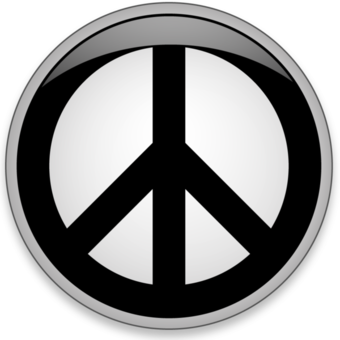
Peace Sign
The peace sign, one of several symbols used to represent peace
